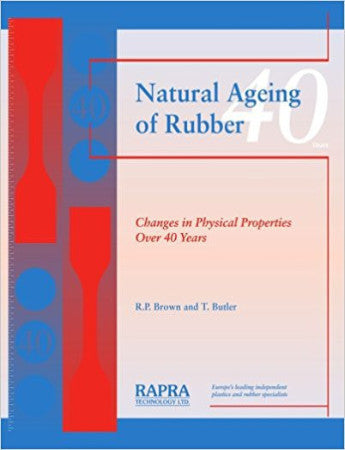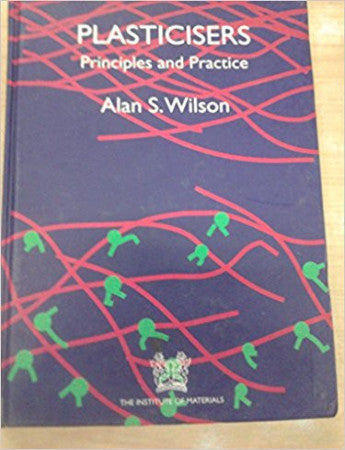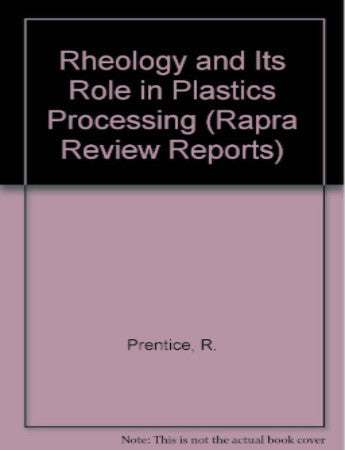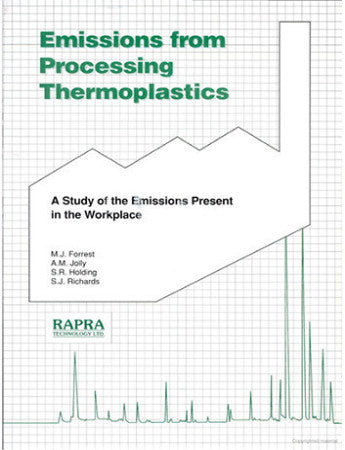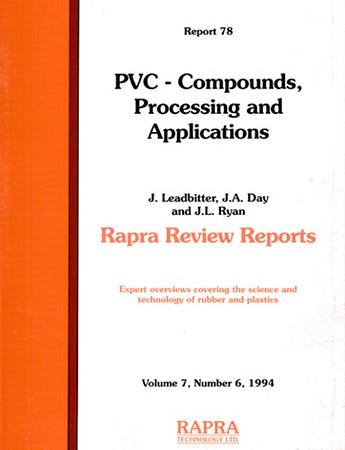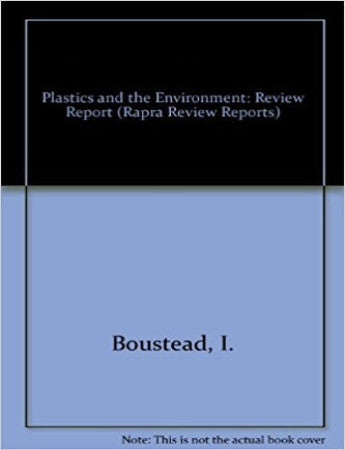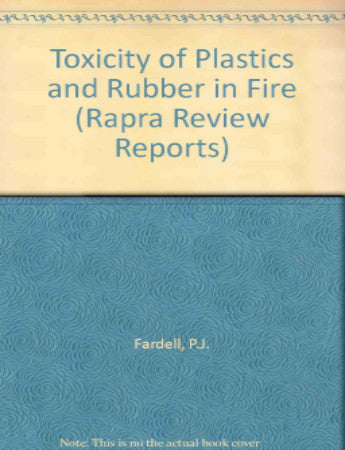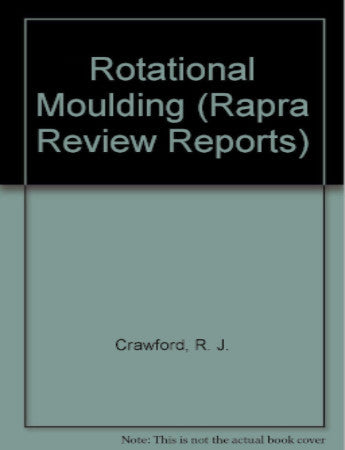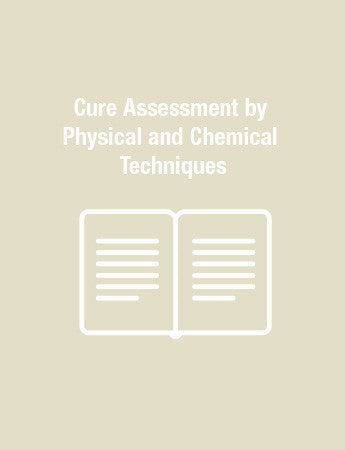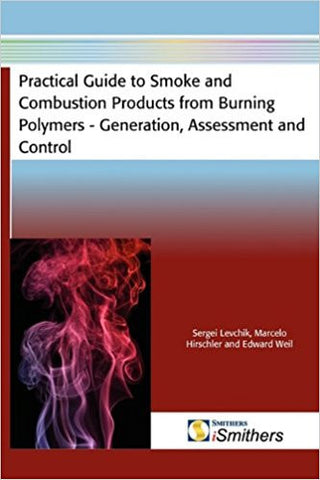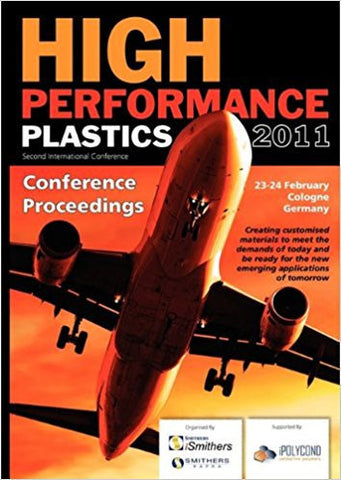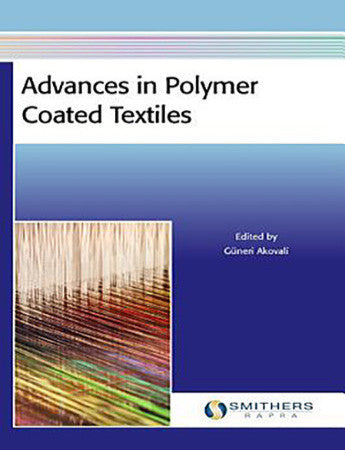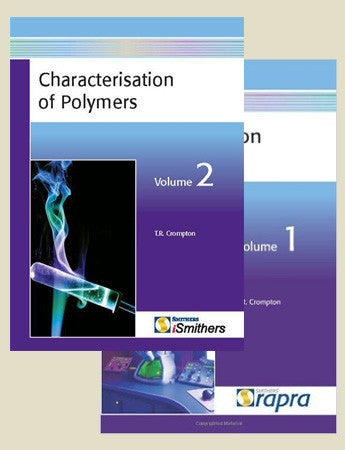Chemtec Publishing offers a large collection of books on polymers, plastics, and rubber.
- Grid List
Filter
Utech 2000
$300.00
{"id":11242258500,"title":"Utech 2000","handle":"978-1-85957-206-1","description":"\u003ch5\u003eDescription\u003c\/h5\u003e\nAuthor: Conference Proceedings \u003cbr\u003eISBN 978-1-85957-206-1 \u003cbr\u003e\u003cbr\u003eNetherlands Congress Centre, The Hague, The Netherlands, 28th-30th March, 2000\u003cbr\u003e\u003cbr\u003epages 460\u003cbr\u003e\n\u003ch5\u003eSummary\u003c\/h5\u003e\nWith the UTECH 2000 event, Crain Communications Ltd, the creators of the UTECH concept, joined forces with ISOPA, the European Isocyanate Producers Association, to produce the most inspirational and informative experience in the polyurethane industry’s calendar. \u003cbr\u003e\u003cbr\u003eThe book covers a wide range of topics and outlines some of the latest developments in the use of polyurethane materials and technology from many of the world’s leading specialists. Several of the presentations also give details of the growing requirements of the polyurethane industry’s downstream customers, offering valuable insights into future demands. \u003cbr\u003e\u003cbr\u003eThe only major polyurethane meeting in the world in 2000, with a brand new format. This three day conference is designed to broaden minds and horizons across the entire industry. The programme of this key event will appeal to a wide spectrum of participants, from commercial strategists to technical innovators. \u003cbr\u003e\u003cbr\u003eThe papers at this ninth such event detail some of the massive strides the industry has made in meeting the exacting technical demands of its wide range of industrial customers in all of the key application sectors. The presentations provide an invaluable guide to the various technical advances and show the depth of expertise of these specialists as well as willingness to share often hard-worked experitise. \u003cbr\u003e\u003cbr\u003eSessions included on: \u003cbr\u003e-Automotive \u003cbr\u003e-Appliance \u003cbr\u003e- Furnishing \u003cbr\u003e-Construction \u003cbr\u003e-Polyurethanes and Sustainable Development \u003cbr\u003e-Case: Coating, Adhesives, Sealants and Elastomers Rigid Foam Developments Other \u003cbr\u003e-Rigid Foam Developments \u003cbr\u003e-Automotive Developments \u003cbr\u003e-Flexible Foam Innovations\u003cbr\u003e\u003cbr\u003e","published_at":"2017-06-22T21:15:39-04:00","created_at":"2017-06-22T21:15:39-04:00","vendor":"Chemtec Publishing","type":"Book","tags":["2000","adhesives","appliance","automotive","book","coating","construction","elastomers","flexible foam","furnishing","p-chemistry","polymer","polyurethane","rigid foam","sealants"],"price":30000,"price_min":30000,"price_max":30000,"available":true,"price_varies":false,"compare_at_price":null,"compare_at_price_min":0,"compare_at_price_max":0,"compare_at_price_varies":false,"variants":[{"id":43378506628,"title":"Default Title","option1":"Default Title","option2":null,"option3":null,"sku":"","requires_shipping":true,"taxable":true,"featured_image":null,"available":true,"name":"Utech 2000","public_title":null,"options":["Default Title"],"price":30000,"weight":1000,"compare_at_price":null,"inventory_quantity":1,"inventory_management":null,"inventory_policy":"continue","barcode":"978-1-85957-206-1","requires_selling_plan":false,"selling_plan_allocations":[]}],"images":[],"featured_image":null,"options":["Title"],"requires_selling_plan":false,"selling_plan_groups":[],"content":"\u003ch5\u003eDescription\u003c\/h5\u003e\nAuthor: Conference Proceedings \u003cbr\u003eISBN 978-1-85957-206-1 \u003cbr\u003e\u003cbr\u003eNetherlands Congress Centre, The Hague, The Netherlands, 28th-30th March, 2000\u003cbr\u003e\u003cbr\u003epages 460\u003cbr\u003e\n\u003ch5\u003eSummary\u003c\/h5\u003e\nWith the UTECH 2000 event, Crain Communications Ltd, the creators of the UTECH concept, joined forces with ISOPA, the European Isocyanate Producers Association, to produce the most inspirational and informative experience in the polyurethane industry’s calendar. \u003cbr\u003e\u003cbr\u003eThe book covers a wide range of topics and outlines some of the latest developments in the use of polyurethane materials and technology from many of the world’s leading specialists. Several of the presentations also give details of the growing requirements of the polyurethane industry’s downstream customers, offering valuable insights into future demands. \u003cbr\u003e\u003cbr\u003eThe only major polyurethane meeting in the world in 2000, with a brand new format. This three day conference is designed to broaden minds and horizons across the entire industry. The programme of this key event will appeal to a wide spectrum of participants, from commercial strategists to technical innovators. \u003cbr\u003e\u003cbr\u003eThe papers at this ninth such event detail some of the massive strides the industry has made in meeting the exacting technical demands of its wide range of industrial customers in all of the key application sectors. The presentations provide an invaluable guide to the various technical advances and show the depth of expertise of these specialists as well as willingness to share often hard-worked experitise. \u003cbr\u003e\u003cbr\u003eSessions included on: \u003cbr\u003e-Automotive \u003cbr\u003e-Appliance \u003cbr\u003e- Furnishing \u003cbr\u003e-Construction \u003cbr\u003e-Polyurethanes and Sustainable Development \u003cbr\u003e-Case: Coating, Adhesives, Sealants and Elastomers Rigid Foam Developments Other \u003cbr\u003e-Rigid Foam Developments \u003cbr\u003e-Automotive Developments \u003cbr\u003e-Flexible Foam Innovations\u003cbr\u003e\u003cbr\u003e"}
Natural Ageing of Rubb...
$220.00
{"id":11242258564,"title":"Natural Ageing of Rubber: Changes in Physical Properties Over 40 Years","handle":"978-1-85957-209-2","description":"\u003ch5\u003eDescription\u003c\/h5\u003e\nAuthor: R.P. Brown and T. Butler \u003cbr\u003eISBN 978-1-85957-209-2 \u003cbr\u003e\u003cbr\u003epages 175\n\u003ch5\u003eSummary\u003c\/h5\u003e\nA unique collection of long-term ageing data, available for the first time, from Rapra Technology Limited. \u003cbr\u003eThis report is an output from the Weathering of Elastomers and Sealants project which forms part of the UK government’s Department of Trade and Industry’s Degradation of Materials in Aggressive Environments Programme. \u003cbr\u003e\u003cbr\u003eRapra Technology Limited has just completed a comprehensive natural ageing and physical testing programme on 19 rubber compounds, stored in controlled conditions, for a period of 40 years. This is believed to be the most extensive such study ever carried out. Now, for the first time, all the results of this unique programme have been published in this report. \u003cbr\u003e\u003cbr\u003eThe properties of natural and synthetic rubbers suit them to a diverse range of applications, many of which demand a prolonged service life, and the retention of some or all of their mechanical properties for years or even decades. When the ageing programme was conceived in the 1950s, rubber product manufacturers were faced with a wider range of raw rubbers than had ever been available before. The relatively recent development of some of these materials also meant that there was little information available regarding their longevity. Thus the need was identified for a systematic programme of storage and testing. \u003cbr\u003e\u003cbr\u003eRubber formulations were selected to represent those used in a wide range of applications, including general purpose and ‘good ageing’ grades. Remarkably, most of these formulations are still representative of compounds being specified today. The following rubbers were studied: \u003cbr\u003e\u003cbr\u003e-Natural rubber \u003cbr\u003e-Styrene-butadiene rubber \u003cbr\u003e-Butyl rubber \u003cbr\u003e-Polychloroprene \u003cbr\u003e-Nitrile rubber \u003cbr\u003e-Acrylate rubber \u003cbr\u003e-Chlorosulphonated polyethylene \u003cbr\u003e-Polysulphide rubber \u003cbr\u003e-Silicone rubber \u003cbr\u003eSamples were stored under temperate and tropical climatic conditions, and at various intervals, the following properties were measured: \u003cbr\u003e\u003cbr\u003e-Hardness \u003cbr\u003e-Volume change \u003cbr\u003e-Resilience \u003cbr\u003e-Volume and surface resistivity \u003cbr\u003e-Tensile strength Elongation at break \u003cbr\u003e-Modulus at 100% and 300% elongation \u003cbr\u003e-Long and short-term compression set \u003cbr\u003e-Low temperature stiffness \u003cbr\u003eThe results of all these tests are presented graphically in this report, allowing the rate of deterioration of properties and the influence of the environment to be clearly seen. Properties after 40 years are also tabulated, together with calculations of percentage change. \u003cbr\u003e\u003cbr\u003eThis information will prove invaluable to anyone specifying or supplying rubber materials or components. Further work is now being carried out on the properties of the same formulations after accelerated ageing.\u003cbr\u003e\u003cbr\u003e","published_at":"2017-06-22T21:15:39-04:00","created_at":"2017-06-22T21:15:39-04:00","vendor":"Chemtec Publishing","type":"Book","tags":["2000","acrylate rubber","book","butyl rubber","compounding of rubber","compression","elongation at break","hardness","health","natural rubber","nitrile rubber","polychloroprene","polysulphide rubber","r-compounding","r-properties","resilience","rubber","safety","silicone rubber","styrene-butadiene rubber","surface resistivity","tensile strength","toxicity","volume change","volume resistivity"],"price":22000,"price_min":22000,"price_max":22000,"available":true,"price_varies":false,"compare_at_price":null,"compare_at_price_min":0,"compare_at_price_max":0,"compare_at_price_varies":false,"variants":[{"id":43378507908,"title":"Default Title","option1":"Default Title","option2":null,"option3":null,"sku":"","requires_shipping":true,"taxable":true,"featured_image":null,"available":true,"name":"Natural Ageing of Rubber: Changes in Physical Properties Over 40 Years","public_title":null,"options":["Default Title"],"price":22000,"weight":1000,"compare_at_price":null,"inventory_quantity":1,"inventory_management":null,"inventory_policy":"continue","barcode":"978-1-85957-209-2","requires_selling_plan":false,"selling_plan_allocations":[]}],"images":["\/\/chemtec.org\/cdn\/shop\/products\/978-1-85957-209-2.jpg?v=1499727722"],"featured_image":"\/\/chemtec.org\/cdn\/shop\/products\/978-1-85957-209-2.jpg?v=1499727722","options":["Title"],"media":[{"alt":null,"id":358525337693,"position":1,"preview_image":{"aspect_ratio":0.767,"height":450,"width":345,"src":"\/\/chemtec.org\/cdn\/shop\/products\/978-1-85957-209-2.jpg?v=1499727722"},"aspect_ratio":0.767,"height":450,"media_type":"image","src":"\/\/chemtec.org\/cdn\/shop\/products\/978-1-85957-209-2.jpg?v=1499727722","width":345}],"requires_selling_plan":false,"selling_plan_groups":[],"content":"\u003ch5\u003eDescription\u003c\/h5\u003e\nAuthor: R.P. Brown and T. Butler \u003cbr\u003eISBN 978-1-85957-209-2 \u003cbr\u003e\u003cbr\u003epages 175\n\u003ch5\u003eSummary\u003c\/h5\u003e\nA unique collection of long-term ageing data, available for the first time, from Rapra Technology Limited. \u003cbr\u003eThis report is an output from the Weathering of Elastomers and Sealants project which forms part of the UK government’s Department of Trade and Industry’s Degradation of Materials in Aggressive Environments Programme. \u003cbr\u003e\u003cbr\u003eRapra Technology Limited has just completed a comprehensive natural ageing and physical testing programme on 19 rubber compounds, stored in controlled conditions, for a period of 40 years. This is believed to be the most extensive such study ever carried out. Now, for the first time, all the results of this unique programme have been published in this report. \u003cbr\u003e\u003cbr\u003eThe properties of natural and synthetic rubbers suit them to a diverse range of applications, many of which demand a prolonged service life, and the retention of some or all of their mechanical properties for years or even decades. When the ageing programme was conceived in the 1950s, rubber product manufacturers were faced with a wider range of raw rubbers than had ever been available before. The relatively recent development of some of these materials also meant that there was little information available regarding their longevity. Thus the need was identified for a systematic programme of storage and testing. \u003cbr\u003e\u003cbr\u003eRubber formulations were selected to represent those used in a wide range of applications, including general purpose and ‘good ageing’ grades. Remarkably, most of these formulations are still representative of compounds being specified today. The following rubbers were studied: \u003cbr\u003e\u003cbr\u003e-Natural rubber \u003cbr\u003e-Styrene-butadiene rubber \u003cbr\u003e-Butyl rubber \u003cbr\u003e-Polychloroprene \u003cbr\u003e-Nitrile rubber \u003cbr\u003e-Acrylate rubber \u003cbr\u003e-Chlorosulphonated polyethylene \u003cbr\u003e-Polysulphide rubber \u003cbr\u003e-Silicone rubber \u003cbr\u003eSamples were stored under temperate and tropical climatic conditions, and at various intervals, the following properties were measured: \u003cbr\u003e\u003cbr\u003e-Hardness \u003cbr\u003e-Volume change \u003cbr\u003e-Resilience \u003cbr\u003e-Volume and surface resistivity \u003cbr\u003e-Tensile strength Elongation at break \u003cbr\u003e-Modulus at 100% and 300% elongation \u003cbr\u003e-Long and short-term compression set \u003cbr\u003e-Low temperature stiffness \u003cbr\u003eThe results of all these tests are presented graphically in this report, allowing the rate of deterioration of properties and the influence of the environment to be clearly seen. Properties after 40 years are also tabulated, together with calculations of percentage change. \u003cbr\u003e\u003cbr\u003eThis information will prove invaluable to anyone specifying or supplying rubber materials or components. Further work is now being carried out on the properties of the same formulations after accelerated ageing.\u003cbr\u003e\u003cbr\u003e"}
Utech Asia 99
$95.00
{"id":11242258244,"title":"Utech Asia 99","handle":"978-1-85957-157-6","description":"\u003ch5\u003eDescription\u003c\/h5\u003e\nAuthor: Conference \u003cbr\u003eISBN 978-1-85957-157-6 \u003cbr\u003e\u003cbr\u003e\n\u003ch5\u003eSummary\u003c\/h5\u003e\nThe Utech Asia 99 conference book of papers is a compilation of more than 50 major presentations detailing the recent developments in polyurethane technology. The papers from this conference detail some of the massive strides the industry has made in meeting the exacting technical demands of its wide range of industrial customers in all key application sectors.","published_at":"2017-06-22T21:15:38-04:00","created_at":"2017-06-22T21:15:38-04:00","vendor":"Chemtec Publishing","type":"Book","tags":["1999","book","p-chemistry","polymer","polyurethanes"],"price":9500,"price_min":9500,"price_max":9500,"available":true,"price_varies":false,"compare_at_price":null,"compare_at_price_min":0,"compare_at_price_max":0,"compare_at_price_varies":false,"variants":[{"id":43378502980,"title":"Default Title","option1":"Default Title","option2":null,"option3":null,"sku":"","requires_shipping":true,"taxable":true,"featured_image":null,"available":true,"name":"Utech Asia 99","public_title":null,"options":["Default Title"],"price":9500,"weight":1000,"compare_at_price":null,"inventory_quantity":1,"inventory_management":null,"inventory_policy":"continue","barcode":"978-1-85957-157-6","requires_selling_plan":false,"selling_plan_allocations":[]}],"images":[],"featured_image":null,"options":["Title"],"requires_selling_plan":false,"selling_plan_groups":[],"content":"\u003ch5\u003eDescription\u003c\/h5\u003e\nAuthor: Conference \u003cbr\u003eISBN 978-1-85957-157-6 \u003cbr\u003e\u003cbr\u003e\n\u003ch5\u003eSummary\u003c\/h5\u003e\nThe Utech Asia 99 conference book of papers is a compilation of more than 50 major presentations detailing the recent developments in polyurethane technology. The papers from this conference detail some of the massive strides the industry has made in meeting the exacting technical demands of its wide range of industrial customers in all key application sectors."}
Toxicity and Safe Hand...
$310.00
{"id":11242258308,"title":"Toxicity and Safe Handling of Rubber Chemicals, Fourth Edition","handle":"978-1-85957-174-3","description":"\u003ch5\u003eDescription\u003c\/h5\u003e\nAuthor: Rapra Technology and BRMA \u003cbr\u003eISBN 978-1-85957-174-3 \u003cbr\u003e\u003cbr\u003e \u003cmeta charset=\"utf-8\"\u003e\n\u003cp\u003e\u003cspan\u003ePublished: 1999 \u003c\/span\u003e\u003cbr\u003ePages 380, \u003cspan\u003eSpiral-bound\u003c\/span\u003e\u003c\/p\u003e\n\u003ch5\u003eSummary\u003c\/h5\u003e\n‘Reliable and authoritative information on the risks associated with the handling and use of chemicals is a prerequisite for their proper control and for preventing risks to health and safety…..To have this key information assembled in a readily accessible and user-friendly form is a considerable bonus, and in publishing this much-revised version of their Code of Practice, the BRMA has performed a valuable service for all the people, managers and workers alike, who earn their livelihoods in the rubber industry.’ - Andrew Porter, Chairman of the Rubber Industry Advisory Committee. \u003cbr\u003e\u003cbr\u003eThis reference book provides an essential guide to health and safety in the rubber processing industry. The British Rubber Manufacturers’ Association and Rapra Technology Limited have combined forces to update the information on hundreds of different rubber chemicals. New data has been compiled from reputable manufacturers and suppliers, and from standard sources of health and safety data. The book includes an introduction to the regulations governing the labeling and use of chemicals, together with definitions of toxicity, carcinogenicity, mutagenicity, and effects on reproduction. Specific hazard, risk, and safety labels are explained. The issue of health surveillance in the industry is dealt with in detail. \u003cbr\u003e\u003cbr\u003eMany rubber chemicals are examined individually in the form of abbreviated safety data sheets. They are listed under categories of use: reinforcing agents and fillers, accelerators and retarders, vulcanising agents, antidegradants, organic peroxides, peptisers and processing aids, ester plasticisers, blowing agents, bonding agents, latex auxiliaries, pigments and miscellaneous. Each chemical has a data sheet including trade names, suppliers, physical data, fire hazards (including explosion risk), regulatory labeling, health hazards, emergency first aid, and food contact listings (FDA and BgVV). New to this edition is the addition of CAS and EINECS numbers to aid identification of materials. \u003cbr\u003e\u003cbr\u003eOther rubber chemicals are discussed as groups: natural and synthetic polymers, process oils and chlorinated waxes, tackifying and reinforcing resins, and rubber solvents. In the section on process oils, there is a discussion on the introduction of new synthetic oils, with reduced aromatic content. \u003cbr\u003e\u003cbr\u003eEnvironmental control is a key issue in today’s world. This book devotes a chapter to the subject of dust and vapour emissions during rubber processing and methods of monitoring. The section on dust includes the latest guidelines, definitions, and significance of respirable and inhalable fractions. There are details of monitoring exposure to mixtures of hydrocarbon solvents, and also of measuring specific vapours (more than thirty different chemicals are listed separately). \u003cbr\u003e\u003cbr\u003eA bibliography is provided for those who wish to study a particular subject in depth. This lists standard toxicology reference books, epidemiological case studies from the rubber industry, and useful publications from the Health and Safety Executive (including the Rubber Industry Advisory Committee, RUBIAC).\u003cbr\u003e\u003cbr\u003e","published_at":"2017-06-22T21:15:38-04:00","created_at":"2017-06-22T21:15:38-04:00","vendor":"Chemtec Publishing","type":"Book","tags":["1999","accelerators","antidegradants","blowing agents","bonding agents","book","emergency","explosion risk","fillers","fire hazards","first aid","food contact","health hazards","labelling","latex auxiliaries","oils","organic peroxides","peptisers","physical data","pigments","plasticisers","polymer","polymers","processing aids","r-health","reinforcing agents","retarders","rubber","solvents.","suppliers","tackifying","vulcanising agents","waxes"],"price":31000,"price_min":31000,"price_max":31000,"available":true,"price_varies":false,"compare_at_price":null,"compare_at_price_min":0,"compare_at_price_max":0,"compare_at_price_varies":false,"variants":[{"id":43378505156,"title":"Default Title","option1":"Default Title","option2":null,"option3":null,"sku":"","requires_shipping":true,"taxable":true,"featured_image":null,"available":true,"name":"Toxicity and Safe Handling of Rubber Chemicals, Fourth Edition","public_title":null,"options":["Default Title"],"price":31000,"weight":1000,"compare_at_price":null,"inventory_quantity":1,"inventory_management":null,"inventory_policy":"continue","barcode":"978-1-85957-174-3","requires_selling_plan":false,"selling_plan_allocations":[]}],"images":[],"featured_image":null,"options":["Title"],"requires_selling_plan":false,"selling_plan_groups":[],"content":"\u003ch5\u003eDescription\u003c\/h5\u003e\nAuthor: Rapra Technology and BRMA \u003cbr\u003eISBN 978-1-85957-174-3 \u003cbr\u003e\u003cbr\u003e \u003cmeta charset=\"utf-8\"\u003e\n\u003cp\u003e\u003cspan\u003ePublished: 1999 \u003c\/span\u003e\u003cbr\u003ePages 380, \u003cspan\u003eSpiral-bound\u003c\/span\u003e\u003c\/p\u003e\n\u003ch5\u003eSummary\u003c\/h5\u003e\n‘Reliable and authoritative information on the risks associated with the handling and use of chemicals is a prerequisite for their proper control and for preventing risks to health and safety…..To have this key information assembled in a readily accessible and user-friendly form is a considerable bonus, and in publishing this much-revised version of their Code of Practice, the BRMA has performed a valuable service for all the people, managers and workers alike, who earn their livelihoods in the rubber industry.’ - Andrew Porter, Chairman of the Rubber Industry Advisory Committee. \u003cbr\u003e\u003cbr\u003eThis reference book provides an essential guide to health and safety in the rubber processing industry. The British Rubber Manufacturers’ Association and Rapra Technology Limited have combined forces to update the information on hundreds of different rubber chemicals. New data has been compiled from reputable manufacturers and suppliers, and from standard sources of health and safety data. The book includes an introduction to the regulations governing the labeling and use of chemicals, together with definitions of toxicity, carcinogenicity, mutagenicity, and effects on reproduction. Specific hazard, risk, and safety labels are explained. The issue of health surveillance in the industry is dealt with in detail. \u003cbr\u003e\u003cbr\u003eMany rubber chemicals are examined individually in the form of abbreviated safety data sheets. They are listed under categories of use: reinforcing agents and fillers, accelerators and retarders, vulcanising agents, antidegradants, organic peroxides, peptisers and processing aids, ester plasticisers, blowing agents, bonding agents, latex auxiliaries, pigments and miscellaneous. Each chemical has a data sheet including trade names, suppliers, physical data, fire hazards (including explosion risk), regulatory labeling, health hazards, emergency first aid, and food contact listings (FDA and BgVV). New to this edition is the addition of CAS and EINECS numbers to aid identification of materials. \u003cbr\u003e\u003cbr\u003eOther rubber chemicals are discussed as groups: natural and synthetic polymers, process oils and chlorinated waxes, tackifying and reinforcing resins, and rubber solvents. In the section on process oils, there is a discussion on the introduction of new synthetic oils, with reduced aromatic content. \u003cbr\u003e\u003cbr\u003eEnvironmental control is a key issue in today’s world. This book devotes a chapter to the subject of dust and vapour emissions during rubber processing and methods of monitoring. The section on dust includes the latest guidelines, definitions, and significance of respirable and inhalable fractions. There are details of monitoring exposure to mixtures of hydrocarbon solvents, and also of measuring specific vapours (more than thirty different chemicals are listed separately). \u003cbr\u003e\u003cbr\u003eA bibliography is provided for those who wish to study a particular subject in depth. This lists standard toxicology reference books, epidemiological case studies from the rubber industry, and useful publications from the Health and Safety Executive (including the Rubber Industry Advisory Committee, RUBIAC).\u003cbr\u003e\u003cbr\u003e"}
Plasticisers: Selectio...
$72.00
{"id":11242257156,"title":"Plasticisers: Selection, Applications and Implications","handle":"978-1-85957-063-0","description":"\u003ch5\u003eDescription\u003c\/h5\u003e\nAuthor: A.S. Wilson \u003cbr\u003eISBN 978-1-85957-063-0 \u003cbr\u003e\u003cbr\u003e\n\u003ch5\u003eSummary\u003c\/h5\u003e\nThis report considers the whole subject of external plasticizers. The following topics are included: function, mechanism and performance criteria, types, selection for application, health and safety issues. The abstract section is also included which contains the most relevant publications.","published_at":"2017-06-22T21:15:35-04:00","created_at":"2017-06-22T21:15:35-04:00","vendor":"Chemtec Publishing","type":"Book","tags":["1995","acrylics","additives","adipates","alkyl sulphonate esters","automotive","azelates","benzoates","book","cellulose esters","chlorinated paraffins","citrates","criteria","epoxies","esters glycols","external plasticizers. function","health","hydrocarbons","mechanism","p-additives","phosphates","phthalates","plasticizing","polyesters","polyhydric alcohols","polymer","polysulphides","polyurethanes","polyvinyl acetate","polyvinyl butyral","PVC","rubber","safety","sebacates","trimellitates","types"],"price":7200,"price_min":7200,"price_max":7200,"available":true,"price_varies":false,"compare_at_price":null,"compare_at_price_min":0,"compare_at_price_max":0,"compare_at_price_varies":false,"variants":[{"id":43378498564,"title":"Default Title","option1":"Default Title","option2":null,"option3":null,"sku":"","requires_shipping":true,"taxable":true,"featured_image":null,"available":true,"name":"Plasticisers: Selection, Applications and Implications","public_title":null,"options":["Default Title"],"price":7200,"weight":1000,"compare_at_price":null,"inventory_quantity":1,"inventory_management":null,"inventory_policy":"continue","barcode":"978-1-85957-063-0","requires_selling_plan":false,"selling_plan_allocations":[]}],"images":["\/\/chemtec.org\/cdn\/shop\/products\/978-1-85957-063-0.jpg?v=1499727801"],"featured_image":"\/\/chemtec.org\/cdn\/shop\/products\/978-1-85957-063-0.jpg?v=1499727801","options":["Title"],"media":[{"alt":null,"id":358532612189,"position":1,"preview_image":{"aspect_ratio":0.767,"height":450,"width":345,"src":"\/\/chemtec.org\/cdn\/shop\/products\/978-1-85957-063-0.jpg?v=1499727801"},"aspect_ratio":0.767,"height":450,"media_type":"image","src":"\/\/chemtec.org\/cdn\/shop\/products\/978-1-85957-063-0.jpg?v=1499727801","width":345}],"requires_selling_plan":false,"selling_plan_groups":[],"content":"\u003ch5\u003eDescription\u003c\/h5\u003e\nAuthor: A.S. Wilson \u003cbr\u003eISBN 978-1-85957-063-0 \u003cbr\u003e\u003cbr\u003e\n\u003ch5\u003eSummary\u003c\/h5\u003e\nThis report considers the whole subject of external plasticizers. The following topics are included: function, mechanism and performance criteria, types, selection for application, health and safety issues. The abstract section is also included which contains the most relevant publications."}
Ring Opening Polymeriz...
$75.00
{"id":11242256772,"title":"Ring Opening Polymerization","handle":"978-1-85957-057-9","description":"\u003ch5\u003eDescription\u003c\/h5\u003e\nAuthor: N. Spassky \u003cbr\u003eISBN 978-1-85957-057-9 \u003cbr\u003e\u003cbr\u003e\u003cmeta charset=\"utf-8\"\u003e\u003cspan\u003ePublished: 1995\u003cbr\u003e\u003c\/span\u003eUniversite Pierre et Marie Curie\u003cbr\u003eReview Report\u003cbr\u003e\u003cbr\u003e101 pages, softbound\u003cbr\u003e\n\u003ch5\u003eSummary\u003c\/h5\u003e\nThe dependence of polymerizability upon ring strain, the significance of ring-chain equilibria, and the potential for formation of cyclic oligomers are outlined. The mechanism and implementation of anionic ring-opening polymerization, cationic ring-opening polymerization, stereospecific coordinated anionic polymerization, free radical ring-opening polymerization, and ionic ring-opening copolymerization are described. A final section on ring-opening metathesis polymerization includes a brief discussion of catalysts, thermodynamics, stereochemistry, kinetics, and applications.","published_at":"2017-06-22T21:15:34-04:00","created_at":"2017-06-22T21:15:34-04:00","vendor":"Chemtec Publishing","type":"Book","tags":["1995","acrylic polymers","book","catalysts","kinetics","p-chemistry","ring opening polymerization","stereochemistry","thermodynamics"],"price":7500,"price_min":7500,"price_max":7500,"available":true,"price_varies":false,"compare_at_price":null,"compare_at_price_min":0,"compare_at_price_max":0,"compare_at_price_varies":false,"variants":[{"id":43378497924,"title":"Default Title","option1":"Default Title","option2":null,"option3":null,"sku":"","requires_shipping":true,"taxable":true,"featured_image":null,"available":true,"name":"Ring Opening Polymerization","public_title":null,"options":["Default Title"],"price":7500,"weight":1000,"compare_at_price":null,"inventory_quantity":1,"inventory_management":null,"inventory_policy":"continue","barcode":"978-1-85957-057-9","requires_selling_plan":false,"selling_plan_allocations":[]}],"images":[],"featured_image":null,"options":["Title"],"requires_selling_plan":false,"selling_plan_groups":[],"content":"\u003ch5\u003eDescription\u003c\/h5\u003e\nAuthor: N. Spassky \u003cbr\u003eISBN 978-1-85957-057-9 \u003cbr\u003e\u003cbr\u003e\u003cmeta charset=\"utf-8\"\u003e\u003cspan\u003ePublished: 1995\u003cbr\u003e\u003c\/span\u003eUniversite Pierre et Marie Curie\u003cbr\u003eReview Report\u003cbr\u003e\u003cbr\u003e101 pages, softbound\u003cbr\u003e\n\u003ch5\u003eSummary\u003c\/h5\u003e\nThe dependence of polymerizability upon ring strain, the significance of ring-chain equilibria, and the potential for formation of cyclic oligomers are outlined. The mechanism and implementation of anionic ring-opening polymerization, cationic ring-opening polymerization, stereospecific coordinated anionic polymerization, free radical ring-opening polymerization, and ionic ring-opening copolymerization are described. A final section on ring-opening metathesis polymerization includes a brief discussion of catalysts, thermodynamics, stereochemistry, kinetics, and applications."}
Rheology and its Role ...
$72.00
{"id":11242256708,"title":"Rheology and its Role in Plastics Processing","handle":"978-1-85957-053-1","description":"\u003ch5\u003eDescription\u003c\/h5\u003e\nAuthor: P. Prentice \u003cbr\u003eISBN 978-1-85957-053-1 \u003cbr\u003e\u003cbr\u003eThe Nottingham Trent University\u003cbr\u003e\u003cbr\u003e\u003cmeta charset=\"utf-8\"\u003e\u003cspan\u003ePublished: 1995\u003cbr\u003e\u003c\/span\u003e94 pages, softbound\u003cbr\u003e\n\u003ch5\u003eSummary\u003c\/h5\u003e\nThis review encompases fundamental principles and rheological equations of state, polymer melt rheology (shear and extensional flow, viscoelasticity, die swell and melt fracture) and rheological measurement techniques. It describes the main plastics processing techniques and explains the influence of polymer melt rheology upon their operation. 48 figures and more than 80 equations enhance the review, which is also supported by extensive, indexed bibliography.\u003cbr\u003e\u003cbr\u003e\u003cstrong\u003eFrom the Table of Contents:\u003c\/strong\u003e \u003cbr\u003e\n\u003cul\u003e\n\u003cli\u003eRheological Equations of State\u003c\/li\u003e\n\u003cli\u003eFundamental Principles of Rheology\u003c\/li\u003e\n\u003cli\u003ePolymer Melt Rheology\u003c\/li\u003e\n\u003cli\u003eRheological Techniques\u003c\/li\u003e\n\u003cli\u003ePolymer Processing (extrusion, injection molding, calendering, rotational casting)\u003c\/li\u003e\n\u003cli\u003eThe Effect of Rheology on Polymer Processing\u003c\/li\u003e\n\u003cli\u003eRheology in the Design\u003c\/li\u003e\n\u003c\/ul\u003e","published_at":"2017-06-22T21:15:34-04:00","created_at":"2017-06-22T21:15:34-04:00","vendor":"Chemtec Publishing","type":"Book","tags":["1995","book","calendering","extrusion","injection molding","moulding","p-properties","plastics","polymer","polymers","processing","rheology","rotational casting"],"price":7200,"price_min":7200,"price_max":7200,"available":true,"price_varies":false,"compare_at_price":null,"compare_at_price_min":0,"compare_at_price_max":0,"compare_at_price_varies":false,"variants":[{"id":43378497860,"title":"Default Title","option1":"Default Title","option2":null,"option3":null,"sku":"","requires_shipping":true,"taxable":true,"featured_image":null,"available":true,"name":"Rheology and its Role in Plastics Processing","public_title":null,"options":["Default Title"],"price":7200,"weight":1000,"compare_at_price":null,"inventory_quantity":1,"inventory_management":null,"inventory_policy":"continue","barcode":"978-1-85957-053-1","requires_selling_plan":false,"selling_plan_allocations":[]}],"images":["\/\/chemtec.org\/cdn\/shop\/products\/978-1-85957-053-1.jpg?v=1499954183"],"featured_image":"\/\/chemtec.org\/cdn\/shop\/products\/978-1-85957-053-1.jpg?v=1499954183","options":["Title"],"media":[{"alt":null,"id":358734987357,"position":1,"preview_image":{"aspect_ratio":0.767,"height":450,"width":345,"src":"\/\/chemtec.org\/cdn\/shop\/products\/978-1-85957-053-1.jpg?v=1499954183"},"aspect_ratio":0.767,"height":450,"media_type":"image","src":"\/\/chemtec.org\/cdn\/shop\/products\/978-1-85957-053-1.jpg?v=1499954183","width":345}],"requires_selling_plan":false,"selling_plan_groups":[],"content":"\u003ch5\u003eDescription\u003c\/h5\u003e\nAuthor: P. Prentice \u003cbr\u003eISBN 978-1-85957-053-1 \u003cbr\u003e\u003cbr\u003eThe Nottingham Trent University\u003cbr\u003e\u003cbr\u003e\u003cmeta charset=\"utf-8\"\u003e\u003cspan\u003ePublished: 1995\u003cbr\u003e\u003c\/span\u003e94 pages, softbound\u003cbr\u003e\n\u003ch5\u003eSummary\u003c\/h5\u003e\nThis review encompases fundamental principles and rheological equations of state, polymer melt rheology (shear and extensional flow, viscoelasticity, die swell and melt fracture) and rheological measurement techniques. It describes the main plastics processing techniques and explains the influence of polymer melt rheology upon their operation. 48 figures and more than 80 equations enhance the review, which is also supported by extensive, indexed bibliography.\u003cbr\u003e\u003cbr\u003e\u003cstrong\u003eFrom the Table of Contents:\u003c\/strong\u003e \u003cbr\u003e\n\u003cul\u003e\n\u003cli\u003eRheological Equations of State\u003c\/li\u003e\n\u003cli\u003eFundamental Principles of Rheology\u003c\/li\u003e\n\u003cli\u003ePolymer Melt Rheology\u003c\/li\u003e\n\u003cli\u003eRheological Techniques\u003c\/li\u003e\n\u003cli\u003ePolymer Processing (extrusion, injection molding, calendering, rotational casting)\u003c\/li\u003e\n\u003cli\u003eThe Effect of Rheology on Polymer Processing\u003c\/li\u003e\n\u003cli\u003eRheology in the Design\u003c\/li\u003e\n\u003c\/ul\u003e"}
Emissions from Process...
$190.00
{"id":11242256452,"title":"Emissions from Processing Thermoplastics","handle":"978-1-85957-041-8","description":"\u003ch5\u003eDescription\u003c\/h5\u003e\nAuthor: M.J. Forrest, A.M. Jolly, S.R. Holding, S. J. Richards \u003cbr\u003eISBN 978-1-85957-041-8 \u003cbr\u003e\u003cbr\u003e62 pages, softbound\n\u003ch5\u003eSummary\u003c\/h5\u003e\n\u003cp\u003eA broad range of bulk thermoplastic materials were studied by monitoring real processing situations (both moulding and extrusion). Materials studied included PVC, nylon 6, ABS, HIPS, LDPE and HDPE. Emissions collected during standard processing and purging operations were analysed by thermal desorption gas chromatography-mass spectrometry.\u003c\/p\u003e","published_at":"2017-06-22T21:15:33-04:00","created_at":"2017-06-22T21:15:33-04:00","vendor":"Chemtec Publishing","type":"Book","tags":["1995","ABS","blow molding","blown film","book","cable","chromatography","environment","extrusion","HDPE","HIPS","injection molding","LDPE","LDPE\/LLDPE","PA-6","PP","PVC","SA","sheet extrusion","spectrometry","tape"],"price":19000,"price_min":19000,"price_max":19000,"available":true,"price_varies":false,"compare_at_price":null,"compare_at_price_min":0,"compare_at_price_max":0,"compare_at_price_varies":false,"variants":[{"id":43378497412,"title":"Default Title","option1":"Default Title","option2":null,"option3":null,"sku":"","requires_shipping":true,"taxable":true,"featured_image":null,"available":true,"name":"Emissions from Processing Thermoplastics","public_title":null,"options":["Default Title"],"price":19000,"weight":1000,"compare_at_price":null,"inventory_quantity":1,"inventory_management":null,"inventory_policy":"continue","barcode":"978-1-85957-041-8","requires_selling_plan":false,"selling_plan_allocations":[]}],"images":["\/\/chemtec.org\/cdn\/shop\/products\/978-1-85957-041-8.jpg?v=1499913691"],"featured_image":"\/\/chemtec.org\/cdn\/shop\/products\/978-1-85957-041-8.jpg?v=1499913691","options":["Title"],"media":[{"alt":null,"id":361594650717,"position":1,"preview_image":{"aspect_ratio":0.767,"height":450,"width":345,"src":"\/\/chemtec.org\/cdn\/shop\/products\/978-1-85957-041-8.jpg?v=1499913691"},"aspect_ratio":0.767,"height":450,"media_type":"image","src":"\/\/chemtec.org\/cdn\/shop\/products\/978-1-85957-041-8.jpg?v=1499913691","width":345}],"requires_selling_plan":false,"selling_plan_groups":[],"content":"\u003ch5\u003eDescription\u003c\/h5\u003e\nAuthor: M.J. Forrest, A.M. Jolly, S.R. Holding, S. J. Richards \u003cbr\u003eISBN 978-1-85957-041-8 \u003cbr\u003e\u003cbr\u003e62 pages, softbound\n\u003ch5\u003eSummary\u003c\/h5\u003e\n\u003cp\u003eA broad range of bulk thermoplastic materials were studied by monitoring real processing situations (both moulding and extrusion). Materials studied included PVC, nylon 6, ABS, HIPS, LDPE and HDPE. Emissions collected during standard processing and purging operations were analysed by thermal desorption gas chromatography-mass spectrometry.\u003c\/p\u003e"}
AddCon '95
$72.00
{"id":11242256388,"title":"AddCon '95","handle":"978-1-85957-037-1","description":"\u003ch5\u003eDescription\u003c\/h5\u003e\nAuthor: Conference \u003cbr\u003eISBN 978-1-85957-037-1 \u003cbr\u003e\u003cbr\u003eWorlwide Additives and Polymer Modifiers Conference Basel, Switzerland\u003cbr\u003e\u003cbr\u003e22 papers, softbound\n\u003ch5\u003eSummary\u003c\/h5\u003e\nList of papers: \u003cbr\u003e\u003cbr\u003ePlastics Material Trends and their Effects upon Additive Consumption, Richard Hudson, Rapra Technology Limited, UK \u003cbr\u003e\u003cbr\u003eVitamin E: A New Primary Antioxidant, Terry Young, Hoffmann-La Roche Inc., USA \u003cbr\u003e\u003cbr\u003eThe Technology of Halogen-Free Flame Retardant Additives tor Polymeric Systems, John Davis, Albright \u0026amp; Wilson UK Ltd., UK \u003cbr\u003e\u003cbr\u003eFR-1808: A Novel Flame Retardant for Environmentally Friendly Applications, Richard Smith, Eurobrom BV, Netherlands \u003cbr\u003e\u003cbr\u003eComparison and Performance of Hydrotalcite Acid Neutralizers in Thermoplastics, Phil Klepak, Reheis Inc., USA \u003cbr\u003e\u003cbr\u003eNext Generation UV Absorbers tor Plastics, R. D. Cody, Cytec Industries, USA \u003cbr\u003e\u003cbr\u003eThe Next Step - Development of a Polymerizable Benzotriazole Stabilizer, Daniel Aultz, Noramco Inc., USA \u003cbr\u003e\u003cbr\u003ePhosphite Stabilizers tor Polyolefins, Don R. Stevenson, Dover Chemical Corporation, USA \u003cbr\u003e\u003cbr\u003eN-Alkoxy Hindered Amines - A New Class of Radical Scavengers, Ravi Ravichandran, Ciba Geigy Corp, USA \u003cbr\u003e\u003cbr\u003eA Universal HALS for the UV Stabilization of Polypropylene, Franco Gratani, Great Lakes Chemical Italia Srl, Italy \u003cbr\u003e\u003cbr\u003eSearch for Stabilizing Effects of Fullerenes in Polymeric Systems, G. David Mendenhall, Michigan Technical University, USA \u003cbr\u003e\u003cbr\u003eFine Particle Titanium Dioxide - Its Properties and Applications in Plastics, Donald R. Robertson, Tioxide Group R \u0026amp; T Plastics, UK \u003cbr\u003e\u003cbr\u003eTougheners Enable New Applications tor PET, J.-P. Meyer, Rohm \u0026amp; Haas France SA, France \u003cbr\u003e\u003cbr\u003eA Synergistic Liquid Antioxidant Blend tor Stabilization of Polyolefins, Steve Pontiff, Synergistic Polymer Systems Inc., USA \u003cbr\u003e\u003cbr\u003eOptimized Stabilizer Systems tor Polyolefins, Francois Gugumus, CIBA Additives, Switzerland \u003cbr\u003e\u003cbr\u003eAdditive Masterbatches Necessary Intermediates in a Quality World, Leopold Katzmayer, Gabriel-Chemie GmbH, Austria \u003cbr\u003e\u003cbr\u003eWire and Cable Compounds Using a Mixture of Chlorinated Organic and Inorganic Flame Retardants, Ronald L Markezich, Occidental Chemical Corporation, USA \u003cbr\u003e\u003cbr\u003eProcessing Additives in Compounding Olefin Polymers, John Vander Kool, Structol Company of America, USA \u003cbr\u003e\u003cbr\u003eFluoropolymer-based Additives Improve Efficiency of Polyolefin Processing and Product Characteristics, Koen Focquet, 3M Specialty Fluoropolymer Dept, Belgium \u003cbr\u003e\u003cbr\u003eSynergistic Stabilizer Blends Containing Novel Phosphite Processing Stabilizers, J. R. Pauquet, Ciba Geigy AG, Switzerland \u003cbr\u003e\u003cbr\u003eBroad Spectrum Processing Aids Based on Multi-Functional Segments Jean-Claude Cardinal, DuPont de Nemours International, Switzerland \u003cbr\u003e\u003cbr\u003eA Study of the Effect of Processing Conditions on the Degradation of Polypropylene, Paul Tock, GE Specialty Chemicals Europe, Netherlands \u003cbr\u003e\u003cbr\u003ePrediction of Nonlinear Viscoelastic Creep in Thin Polyethylene Film from Dynamic Mechanical Data, Alan Letton, Tuskegee University, USA\u003cbr\u003e\u003cbr\u003e\u003cbr\u003e","published_at":"2017-06-22T21:15:33-04:00","created_at":"2017-06-22T21:15:33-04:00","vendor":"Chemtec Publishing","type":"Book","tags":["1995","additives","book","conference","modifiers","plastic","polymer","polymers","stabilizers"],"price":7200,"price_min":7200,"price_max":7200,"available":true,"price_varies":false,"compare_at_price":null,"compare_at_price_min":0,"compare_at_price_max":0,"compare_at_price_varies":false,"variants":[{"id":43378496964,"title":"Default Title","option1":"Default Title","option2":null,"option3":null,"sku":"","requires_shipping":true,"taxable":true,"featured_image":null,"available":true,"name":"AddCon '95","public_title":null,"options":["Default Title"],"price":7200,"weight":1000,"compare_at_price":null,"inventory_quantity":0,"inventory_management":null,"inventory_policy":"continue","barcode":"978-1-85957-037-1","requires_selling_plan":false,"selling_plan_allocations":[]}],"images":["\/\/chemtec.org\/cdn\/shop\/products\/978-1-85957-037-1.jpg?v=1498183829"],"featured_image":"\/\/chemtec.org\/cdn\/shop\/products\/978-1-85957-037-1.jpg?v=1498183829","options":["Title"],"media":[{"alt":null,"id":350137548893,"position":1,"preview_image":{"aspect_ratio":0.767,"height":450,"width":345,"src":"\/\/chemtec.org\/cdn\/shop\/products\/978-1-85957-037-1.jpg?v=1498183829"},"aspect_ratio":0.767,"height":450,"media_type":"image","src":"\/\/chemtec.org\/cdn\/shop\/products\/978-1-85957-037-1.jpg?v=1498183829","width":345}],"requires_selling_plan":false,"selling_plan_groups":[],"content":"\u003ch5\u003eDescription\u003c\/h5\u003e\nAuthor: Conference \u003cbr\u003eISBN 978-1-85957-037-1 \u003cbr\u003e\u003cbr\u003eWorlwide Additives and Polymer Modifiers Conference Basel, Switzerland\u003cbr\u003e\u003cbr\u003e22 papers, softbound\n\u003ch5\u003eSummary\u003c\/h5\u003e\nList of papers: \u003cbr\u003e\u003cbr\u003ePlastics Material Trends and their Effects upon Additive Consumption, Richard Hudson, Rapra Technology Limited, UK \u003cbr\u003e\u003cbr\u003eVitamin E: A New Primary Antioxidant, Terry Young, Hoffmann-La Roche Inc., USA \u003cbr\u003e\u003cbr\u003eThe Technology of Halogen-Free Flame Retardant Additives tor Polymeric Systems, John Davis, Albright \u0026amp; Wilson UK Ltd., UK \u003cbr\u003e\u003cbr\u003eFR-1808: A Novel Flame Retardant for Environmentally Friendly Applications, Richard Smith, Eurobrom BV, Netherlands \u003cbr\u003e\u003cbr\u003eComparison and Performance of Hydrotalcite Acid Neutralizers in Thermoplastics, Phil Klepak, Reheis Inc., USA \u003cbr\u003e\u003cbr\u003eNext Generation UV Absorbers tor Plastics, R. D. Cody, Cytec Industries, USA \u003cbr\u003e\u003cbr\u003eThe Next Step - Development of a Polymerizable Benzotriazole Stabilizer, Daniel Aultz, Noramco Inc., USA \u003cbr\u003e\u003cbr\u003ePhosphite Stabilizers tor Polyolefins, Don R. Stevenson, Dover Chemical Corporation, USA \u003cbr\u003e\u003cbr\u003eN-Alkoxy Hindered Amines - A New Class of Radical Scavengers, Ravi Ravichandran, Ciba Geigy Corp, USA \u003cbr\u003e\u003cbr\u003eA Universal HALS for the UV Stabilization of Polypropylene, Franco Gratani, Great Lakes Chemical Italia Srl, Italy \u003cbr\u003e\u003cbr\u003eSearch for Stabilizing Effects of Fullerenes in Polymeric Systems, G. David Mendenhall, Michigan Technical University, USA \u003cbr\u003e\u003cbr\u003eFine Particle Titanium Dioxide - Its Properties and Applications in Plastics, Donald R. Robertson, Tioxide Group R \u0026amp; T Plastics, UK \u003cbr\u003e\u003cbr\u003eTougheners Enable New Applications tor PET, J.-P. Meyer, Rohm \u0026amp; Haas France SA, France \u003cbr\u003e\u003cbr\u003eA Synergistic Liquid Antioxidant Blend tor Stabilization of Polyolefins, Steve Pontiff, Synergistic Polymer Systems Inc., USA \u003cbr\u003e\u003cbr\u003eOptimized Stabilizer Systems tor Polyolefins, Francois Gugumus, CIBA Additives, Switzerland \u003cbr\u003e\u003cbr\u003eAdditive Masterbatches Necessary Intermediates in a Quality World, Leopold Katzmayer, Gabriel-Chemie GmbH, Austria \u003cbr\u003e\u003cbr\u003eWire and Cable Compounds Using a Mixture of Chlorinated Organic and Inorganic Flame Retardants, Ronald L Markezich, Occidental Chemical Corporation, USA \u003cbr\u003e\u003cbr\u003eProcessing Additives in Compounding Olefin Polymers, John Vander Kool, Structol Company of America, USA \u003cbr\u003e\u003cbr\u003eFluoropolymer-based Additives Improve Efficiency of Polyolefin Processing and Product Characteristics, Koen Focquet, 3M Specialty Fluoropolymer Dept, Belgium \u003cbr\u003e\u003cbr\u003eSynergistic Stabilizer Blends Containing Novel Phosphite Processing Stabilizers, J. R. Pauquet, Ciba Geigy AG, Switzerland \u003cbr\u003e\u003cbr\u003eBroad Spectrum Processing Aids Based on Multi-Functional Segments Jean-Claude Cardinal, DuPont de Nemours International, Switzerland \u003cbr\u003e\u003cbr\u003eA Study of the Effect of Processing Conditions on the Degradation of Polypropylene, Paul Tock, GE Specialty Chemicals Europe, Netherlands \u003cbr\u003e\u003cbr\u003ePrediction of Nonlinear Viscoelastic Creep in Thin Polyethylene Film from Dynamic Mechanical Data, Alan Letton, Tuskegee University, USA\u003cbr\u003e\u003cbr\u003e\u003cbr\u003e"}
Reactive Processing of...
$72.00
{"id":11242255940,"title":"Reactive Processing of Polymers, 1994","handle":"978-1-85957-011-1","description":"\u003ch5\u003eDescription\u003c\/h5\u003e\nAuthor: A.F. Johnson, P.D. Coates, M.W.R. Brown \u003cbr\u003eISBN 978-1-85957-011-1 \u003cbr\u003e\u003cbr\u003e\u003cmeta charset=\"utf-8\"\u003e\u003cspan\u003ePublished: 1994\u003cbr\u003e\u003c\/span\u003e136 pages, softbound\n\u003ch5\u003eSummary\u003c\/h5\u003e\nThe authors survey progress made in the two types of reactive processing: batch and continuous. Developments in machinery, materials, and applications are outlined in the context of commercial considerations and advances in fundamental understanding. The principles and benefits of polymer modification and blending via reactive extrusion are explained. A number of novel techniques are also described. \u003cbr\u003e\u003cbr\u003e\u003cstrong\u003eFrom the Table of Contents:\u003c\/strong\u003e \u003cbr\u003e\n\u003cul\u003e\n\u003cli\u003eReaction Injection molding\u003c\/li\u003e\n\u003cli\u003eReinforced Reaction Injection Molding\u003c\/li\u003e\n\u003cli\u003eStructural Reaction Injection Molding\u003c\/li\u003e\n\u003cli\u003eResin Transfer Molding\u003c\/li\u003e\n\u003cli\u003eReactive Extrusion\u003c\/li\u003e\n\u003cli\u003eMachinery\u003c\/li\u003e\n\u003cli\u003eMaterials\u003c\/li\u003e\n\u003cli\u003eBlends\u003c\/li\u003e\n\u003cli\u003ePolymerization\u003c\/li\u003e\n\u003cli\u003eOther Reactive Processing Technologies\u003c\/li\u003e\n\u003cli\u003eConcluding Comments\u003c\/li\u003e\n\u003c\/ul\u003e","published_at":"2017-06-22T21:15:32-04:00","created_at":"2017-06-22T21:15:32-04:00","vendor":"Chemtec Publishing","type":"Book","tags":["1994","blends","book","chain","crosslinking","extension","extrusion","injection molding","p-processing","poly","polymerisation","polymerization","polymers","processes","processing","production","reactions","resin"],"price":7200,"price_min":7200,"price_max":7200,"available":true,"price_varies":false,"compare_at_price":null,"compare_at_price_min":0,"compare_at_price_max":0,"compare_at_price_varies":false,"variants":[{"id":43378496260,"title":"Default Title","option1":"Default Title","option2":null,"option3":null,"sku":"","requires_shipping":true,"taxable":true,"featured_image":null,"available":true,"name":"Reactive Processing of Polymers, 1994","public_title":null,"options":["Default Title"],"price":7200,"weight":1000,"compare_at_price":null,"inventory_quantity":1,"inventory_management":null,"inventory_policy":"continue","barcode":"978-1-85957-011-1","requires_selling_plan":false,"selling_plan_allocations":[]}],"images":[],"featured_image":null,"options":["Title"],"requires_selling_plan":false,"selling_plan_groups":[],"content":"\u003ch5\u003eDescription\u003c\/h5\u003e\nAuthor: A.F. Johnson, P.D. Coates, M.W.R. Brown \u003cbr\u003eISBN 978-1-85957-011-1 \u003cbr\u003e\u003cbr\u003e\u003cmeta charset=\"utf-8\"\u003e\u003cspan\u003ePublished: 1994\u003cbr\u003e\u003c\/span\u003e136 pages, softbound\n\u003ch5\u003eSummary\u003c\/h5\u003e\nThe authors survey progress made in the two types of reactive processing: batch and continuous. Developments in machinery, materials, and applications are outlined in the context of commercial considerations and advances in fundamental understanding. The principles and benefits of polymer modification and blending via reactive extrusion are explained. A number of novel techniques are also described. \u003cbr\u003e\u003cbr\u003e\u003cstrong\u003eFrom the Table of Contents:\u003c\/strong\u003e \u003cbr\u003e\n\u003cul\u003e\n\u003cli\u003eReaction Injection molding\u003c\/li\u003e\n\u003cli\u003eReinforced Reaction Injection Molding\u003c\/li\u003e\n\u003cli\u003eStructural Reaction Injection Molding\u003c\/li\u003e\n\u003cli\u003eResin Transfer Molding\u003c\/li\u003e\n\u003cli\u003eReactive Extrusion\u003c\/li\u003e\n\u003cli\u003eMachinery\u003c\/li\u003e\n\u003cli\u003eMaterials\u003c\/li\u003e\n\u003cli\u003eBlends\u003c\/li\u003e\n\u003cli\u003ePolymerization\u003c\/li\u003e\n\u003cli\u003eOther Reactive Processing Technologies\u003c\/li\u003e\n\u003cli\u003eConcluding Comments\u003c\/li\u003e\n\u003c\/ul\u003e"}
PVC - Compounds, Proce...
$72.00
{"id":11242256068,"title":"PVC - Compounds, Processing and Applications","handle":"978-1-85957-029-6","description":"\u003ch5\u003eDescription\u003c\/h5\u003e\nAuthor: J. Leadbitter, J.A. Day, J.L. Ryan \u003cbr\u003eISBN 978-1-85957-029-6 \u003cbr\u003e\u003cbr\u003eHydro Polymer Ltd.\u003cbr\u003eReview Report\u003cbr\u003e\u003cmeta charset=\"utf-8\"\u003e\u003cspan\u003ePublished: 1994\u003cbr\u003e\u003c\/span\u003e120 pages, softbound\u003cbr\u003e\n\u003ch5\u003eSummary\u003c\/h5\u003e\nThis report reviews the composition and synthesis of PVC, composition and formulation technology, compounding and manufacturing technology, materials obtained by blending. 500 abstracts outlines suggested references which contain required data. \u003cbr\u003e\u003cbr\u003eFrom the Table of Contents: \u003cbr\u003ePVC Resins \u003cbr\u003eHomopolymers \u003cbr\u003eCopolymers \u003cbr\u003eTerpolymers \u003cbr\u003eChlorinated PVC \u003cbr\u003eCommercial Aspects of PVC \u003cbr\u003eComparison of Formulation Technology \u003cbr\u003eCompounding Technology \u003cbr\u003eProcess Technology \u003cbr\u003ePVC Blends and Alloys\u003cbr\u003e\u003cbr\u003e","published_at":"2017-06-22T21:15:32-04:00","created_at":"2017-06-22T21:15:32-04:00","vendor":"Chemtec Publishing","type":"Book","tags":["1994","alloys","blends","book","composition","copolymer","copolymers","homopolymers","p-chemistry","polymer","PVC compounds","pvc processing"],"price":7200,"price_min":7200,"price_max":7200,"available":true,"price_varies":false,"compare_at_price":null,"compare_at_price_min":0,"compare_at_price_max":0,"compare_at_price_varies":false,"variants":[{"id":43378496644,"title":"Default Title","option1":"Default Title","option2":null,"option3":null,"sku":"","requires_shipping":true,"taxable":true,"featured_image":null,"available":true,"name":"PVC - Compounds, Processing and Applications","public_title":null,"options":["Default Title"],"price":7200,"weight":1000,"compare_at_price":null,"inventory_quantity":0,"inventory_management":null,"inventory_policy":"continue","barcode":"978-1-85957-029-6","requires_selling_plan":false,"selling_plan_allocations":[]}],"images":["\/\/chemtec.org\/cdn\/shop\/products\/978-1-85957-029-6.jpg?v=1504015574"],"featured_image":"\/\/chemtec.org\/cdn\/shop\/products\/978-1-85957-029-6.jpg?v=1504015574","options":["Title"],"media":[{"alt":null,"id":412810444893,"position":1,"preview_image":{"aspect_ratio":0.767,"height":450,"width":345,"src":"\/\/chemtec.org\/cdn\/shop\/products\/978-1-85957-029-6.jpg?v=1504015574"},"aspect_ratio":0.767,"height":450,"media_type":"image","src":"\/\/chemtec.org\/cdn\/shop\/products\/978-1-85957-029-6.jpg?v=1504015574","width":345}],"requires_selling_plan":false,"selling_plan_groups":[],"content":"\u003ch5\u003eDescription\u003c\/h5\u003e\nAuthor: J. Leadbitter, J.A. Day, J.L. Ryan \u003cbr\u003eISBN 978-1-85957-029-6 \u003cbr\u003e\u003cbr\u003eHydro Polymer Ltd.\u003cbr\u003eReview Report\u003cbr\u003e\u003cmeta charset=\"utf-8\"\u003e\u003cspan\u003ePublished: 1994\u003cbr\u003e\u003c\/span\u003e120 pages, softbound\u003cbr\u003e\n\u003ch5\u003eSummary\u003c\/h5\u003e\nThis report reviews the composition and synthesis of PVC, composition and formulation technology, compounding and manufacturing technology, materials obtained by blending. 500 abstracts outlines suggested references which contain required data. \u003cbr\u003e\u003cbr\u003eFrom the Table of Contents: \u003cbr\u003ePVC Resins \u003cbr\u003eHomopolymers \u003cbr\u003eCopolymers \u003cbr\u003eTerpolymers \u003cbr\u003eChlorinated PVC \u003cbr\u003eCommercial Aspects of PVC \u003cbr\u003eComparison of Formulation Technology \u003cbr\u003eCompounding Technology \u003cbr\u003eProcess Technology \u003cbr\u003ePVC Blends and Alloys\u003cbr\u003e\u003cbr\u003e"}
Plastics and the Envir...
$72.00
{"id":11242256004,"title":"Plastics and the Environment","handle":"978-1-85957-016-6","description":"\u003ch5\u003eDescription\u003c\/h5\u003e\nAuthor: I. Boustead \u003cbr\u003eISBN 978-1-85957-016-6 \u003cbr\u003e\u003cbr\u003e110 pages, softbound\n\u003ch5\u003eSummary\u003c\/h5\u003e\nThe plastics industry, like most others, was slow to respond to environmental pressures. Partly as a consequence of this it now faces irrational prejudices and demands which may lead to inappropriate decisions in response to undoubtedly real problems. Plastics possess some special characteristics but most of the potential environmental problems and their solutions are common to other materials and industries.\u003cbr\u003e\u003cbr\u003eThis review considers their environmental impact in terms of industrial systems (e.g. eco-profile and life-cycle systems) and looks at energy consumption and recovery, as well as recycling. It is supported by an extensive bibliography compiled from the Polymer Library.\u003cbr\u003e\u003cbr\u003e","published_at":"2017-06-22T21:15:32-04:00","created_at":"2017-06-22T21:15:32-04:00","vendor":"Chemtec Publishing","type":"Book","tags":["1994","book","energy consumption","environment","plastic","plastics","recovery","recycling"],"price":7200,"price_min":7200,"price_max":7200,"available":true,"price_varies":false,"compare_at_price":null,"compare_at_price_min":0,"compare_at_price_max":0,"compare_at_price_varies":false,"variants":[{"id":43378496580,"title":"Default Title","option1":"Default Title","option2":null,"option3":null,"sku":"","requires_shipping":true,"taxable":true,"featured_image":null,"available":true,"name":"Plastics and the Environment","public_title":null,"options":["Default Title"],"price":7200,"weight":1000,"compare_at_price":null,"inventory_quantity":1,"inventory_management":null,"inventory_policy":"continue","barcode":"978-1-85957-016-6","requires_selling_plan":false,"selling_plan_allocations":[]}],"images":["\/\/chemtec.org\/cdn\/shop\/products\/978-1-85957-016-6.jpg?v=1499725948"],"featured_image":"\/\/chemtec.org\/cdn\/shop\/products\/978-1-85957-016-6.jpg?v=1499725948","options":["Title"],"media":[{"alt":null,"id":358535528541,"position":1,"preview_image":{"aspect_ratio":0.767,"height":450,"width":345,"src":"\/\/chemtec.org\/cdn\/shop\/products\/978-1-85957-016-6.jpg?v=1499725948"},"aspect_ratio":0.767,"height":450,"media_type":"image","src":"\/\/chemtec.org\/cdn\/shop\/products\/978-1-85957-016-6.jpg?v=1499725948","width":345}],"requires_selling_plan":false,"selling_plan_groups":[],"content":"\u003ch5\u003eDescription\u003c\/h5\u003e\nAuthor: I. Boustead \u003cbr\u003eISBN 978-1-85957-016-6 \u003cbr\u003e\u003cbr\u003e110 pages, softbound\n\u003ch5\u003eSummary\u003c\/h5\u003e\nThe plastics industry, like most others, was slow to respond to environmental pressures. Partly as a consequence of this it now faces irrational prejudices and demands which may lead to inappropriate decisions in response to undoubtedly real problems. Plastics possess some special characteristics but most of the potential environmental problems and their solutions are common to other materials and industries.\u003cbr\u003e\u003cbr\u003eThis review considers their environmental impact in terms of industrial systems (e.g. eco-profile and life-cycle systems) and looks at energy consumption and recovery, as well as recycling. It is supported by an extensive bibliography compiled from the Polymer Library.\u003cbr\u003e\u003cbr\u003e"}
Toxicity of Plastics a...
$75.00
{"id":11242255684,"title":"Toxicity of Plastics and Rubber in Fire","handle":"978-1-85957-001-2","description":"\u003ch5\u003eDescription\u003c\/h5\u003e\nAuthor: P.J. Fardell \u003cbr\u003eISBN 978-1-85957-001-2 \u003cbr\u003e\u003cbr\u003e\u003cmeta charset=\"utf-8\"\u003e\u003cspan\u003ePublished: 1993\u003cbr\u003e\u003c\/span\u003e101 pages, softbound\n\u003ch5\u003eSummary\u003c\/h5\u003e\nThis Rapra Review Report does not seek to single out synthetic polymers as a special case. It aims to provide an overview of the whole subject of combustion toxicity and a threat to life, whilst supplying specific information on the most frequently encountered polymeric materials, and combustion products such as dioxins which have received high levels of media attention. The coverage of the review includes the nature and types of fires, biological effects, explanations of combustion toxicity, toxic hazard, risk and life threat, and methods for their measurement or evaluation. Notes are provided on specific polymers, and much additional performance data and discussion are provided by the 423 abstracts of published papers, selected from the Polymer Library, which complete the report.","published_at":"2017-06-22T21:15:31-04:00","created_at":"2017-06-22T21:15:31-04:00","vendor":"Chemtec Publishing","type":"Book","tags":["1993","biological hazard","book","fire","life threat","plastics","polymers","r-health","rubber","toxic","toxicity"],"price":7500,"price_min":7500,"price_max":7500,"available":true,"price_varies":false,"compare_at_price":null,"compare_at_price_min":0,"compare_at_price_max":0,"compare_at_price_varies":false,"variants":[{"id":43378493828,"title":"Default Title","option1":"Default Title","option2":null,"option3":null,"sku":"","requires_shipping":true,"taxable":true,"featured_image":null,"available":true,"name":"Toxicity of Plastics and Rubber in Fire","public_title":null,"options":["Default Title"],"price":7500,"weight":1000,"compare_at_price":null,"inventory_quantity":1,"inventory_management":null,"inventory_policy":"continue","barcode":"978-1-85957-001-2","requires_selling_plan":false,"selling_plan_allocations":[]}],"images":["\/\/chemtec.org\/cdn\/shop\/products\/978-1-85957-001-2_60e0eb86-a722-4850-826a-2f7f769241d5.jpg?v=1499728141"],"featured_image":"\/\/chemtec.org\/cdn\/shop\/products\/978-1-85957-001-2_60e0eb86-a722-4850-826a-2f7f769241d5.jpg?v=1499728141","options":["Title"],"media":[{"alt":null,"id":358827589725,"position":1,"preview_image":{"aspect_ratio":0.767,"height":450,"width":345,"src":"\/\/chemtec.org\/cdn\/shop\/products\/978-1-85957-001-2_60e0eb86-a722-4850-826a-2f7f769241d5.jpg?v=1499728141"},"aspect_ratio":0.767,"height":450,"media_type":"image","src":"\/\/chemtec.org\/cdn\/shop\/products\/978-1-85957-001-2_60e0eb86-a722-4850-826a-2f7f769241d5.jpg?v=1499728141","width":345}],"requires_selling_plan":false,"selling_plan_groups":[],"content":"\u003ch5\u003eDescription\u003c\/h5\u003e\nAuthor: P.J. Fardell \u003cbr\u003eISBN 978-1-85957-001-2 \u003cbr\u003e\u003cbr\u003e\u003cmeta charset=\"utf-8\"\u003e\u003cspan\u003ePublished: 1993\u003cbr\u003e\u003c\/span\u003e101 pages, softbound\n\u003ch5\u003eSummary\u003c\/h5\u003e\nThis Rapra Review Report does not seek to single out synthetic polymers as a special case. It aims to provide an overview of the whole subject of combustion toxicity and a threat to life, whilst supplying specific information on the most frequently encountered polymeric materials, and combustion products such as dioxins which have received high levels of media attention. The coverage of the review includes the nature and types of fires, biological effects, explanations of combustion toxicity, toxic hazard, risk and life threat, and methods for their measurement or evaluation. Notes are provided on specific polymers, and much additional performance data and discussion are provided by the 423 abstracts of published papers, selected from the Polymer Library, which complete the report."}
Rotational Molding
$75.00
{"id":11242255812,"title":"Rotational Molding","handle":"978-1-85957-009-8","description":"\u003ch5\u003eDescription\u003c\/h5\u003e\nAuthor: R.J. Crawford \u003cbr\u003eISBN 978-1-85957-009-8 \u003cbr\u003e\u003cbr\u003eThe Queens University of Belfast\u003cbr\u003eReview Report\u003cbr\u003e\u003cbr\u003e\u003cmeta charset=\"utf-8\"\u003e\u003cspan\u003ePublished: 1993\u003cbr\u003e\u003c\/span\u003e86 pages, softbound\u003cbr\u003e\n\u003ch5\u003eSummary\u003c\/h5\u003e\nProf. Crawford explains the fundamentals of rotational molding, with particular reference to advances in the key areas of materials, machinery, molds, and process control. He considers relationships between processing conditions and product properties and looks at the future of the process and the likely advances still to be made. More than 350 abstracts were selected as references.","published_at":"2017-06-22T21:15:31-04:00","created_at":"2017-06-22T21:15:31-04:00","vendor":"Chemtec Publishing","type":"Book","tags":["1993","book","machinery","materials","molds","moulding","p-processing","polymer","process control","rotational molding"],"price":7500,"price_min":7500,"price_max":7500,"available":true,"price_varies":false,"compare_at_price":null,"compare_at_price_min":0,"compare_at_price_max":0,"compare_at_price_varies":false,"variants":[{"id":43378495556,"title":"Default Title","option1":"Default Title","option2":null,"option3":null,"sku":"","requires_shipping":true,"taxable":true,"featured_image":null,"available":true,"name":"Rotational Molding","public_title":null,"options":["Default Title"],"price":7500,"weight":1000,"compare_at_price":null,"inventory_quantity":1,"inventory_management":null,"inventory_policy":"continue","barcode":"978-1-85957-009-8","requires_selling_plan":false,"selling_plan_allocations":[]}],"images":["\/\/chemtec.org\/cdn\/shop\/products\/978-1-85957-009-8.jpg?v=1499954895"],"featured_image":"\/\/chemtec.org\/cdn\/shop\/products\/978-1-85957-009-8.jpg?v=1499954895","options":["Title"],"media":[{"alt":null,"id":358738886749,"position":1,"preview_image":{"aspect_ratio":0.767,"height":450,"width":345,"src":"\/\/chemtec.org\/cdn\/shop\/products\/978-1-85957-009-8.jpg?v=1499954895"},"aspect_ratio":0.767,"height":450,"media_type":"image","src":"\/\/chemtec.org\/cdn\/shop\/products\/978-1-85957-009-8.jpg?v=1499954895","width":345}],"requires_selling_plan":false,"selling_plan_groups":[],"content":"\u003ch5\u003eDescription\u003c\/h5\u003e\nAuthor: R.J. Crawford \u003cbr\u003eISBN 978-1-85957-009-8 \u003cbr\u003e\u003cbr\u003eThe Queens University of Belfast\u003cbr\u003eReview Report\u003cbr\u003e\u003cbr\u003e\u003cmeta charset=\"utf-8\"\u003e\u003cspan\u003ePublished: 1993\u003cbr\u003e\u003c\/span\u003e86 pages, softbound\u003cbr\u003e\n\u003ch5\u003eSummary\u003c\/h5\u003e\nProf. Crawford explains the fundamentals of rotational molding, with particular reference to advances in the key areas of materials, machinery, molds, and process control. He considers relationships between processing conditions and product properties and looks at the future of the process and the likely advances still to be made. More than 350 abstracts were selected as references."}
Cure Assessment by Phy...
$72.00
{"id":11242255556,"title":"Cure Assessment by Physical and Chemical Techniques","handle":"978-1-85957-000-5","description":"\u003ch5\u003eDescription\u003c\/h5\u003e\nAuthor: B.G. Willoughby \u003cbr\u003eISBN 978-1-85957-000-5 \u003cbr\u003e\u003cbr\u003eReview Report\u003cbr\u003e\u003cbr\u003e122 pages, softbound\u003cbr\u003e\n\u003ch5\u003eSummary\u003c\/h5\u003e\nCure process description is used for the review of the theory and implementation of a wide range of measuring techniques. Techniques include: modulus, hardness, viscosity \u0026amp; swelling, dielectric \u0026amp; ultrasonic techniques, IR, NMR, GC, DSC, and wet analytical techniques. There is also an index section of over 500 abstracts of relevant papers.","published_at":"2017-06-22T21:15:31-04:00","created_at":"2017-06-22T21:15:31-04:00","vendor":"Chemtec Publishing","type":"Book","tags":["1994","book","cure assessment","dielectric ultrasonic techniques","DSC","GC","hardness","IR","modulus","NMR","p-testing","polymer","polymers","viscosity swelling","wet analytical techniques"],"price":7200,"price_min":7200,"price_max":7200,"available":true,"price_varies":false,"compare_at_price":null,"compare_at_price_min":0,"compare_at_price_max":0,"compare_at_price_varies":false,"variants":[{"id":43378492804,"title":"Default Title","option1":"Default Title","option2":null,"option3":null,"sku":"","requires_shipping":true,"taxable":true,"featured_image":null,"available":true,"name":"Cure Assessment by Physical and Chemical Techniques","public_title":null,"options":["Default Title"],"price":7200,"weight":1000,"compare_at_price":null,"inventory_quantity":1,"inventory_management":null,"inventory_policy":"continue","barcode":"978-1-85957-000-5","requires_selling_plan":false,"selling_plan_allocations":[]}],"images":["\/\/chemtec.org\/cdn\/shop\/products\/978-1-85957-000-5.jpg?v=1499212058"],"featured_image":"\/\/chemtec.org\/cdn\/shop\/products\/978-1-85957-000-5.jpg?v=1499212058","options":["Title"],"media":[{"alt":null,"id":353967702109,"position":1,"preview_image":{"aspect_ratio":0.767,"height":450,"width":345,"src":"\/\/chemtec.org\/cdn\/shop\/products\/978-1-85957-000-5.jpg?v=1499212058"},"aspect_ratio":0.767,"height":450,"media_type":"image","src":"\/\/chemtec.org\/cdn\/shop\/products\/978-1-85957-000-5.jpg?v=1499212058","width":345}],"requires_selling_plan":false,"selling_plan_groups":[],"content":"\u003ch5\u003eDescription\u003c\/h5\u003e\nAuthor: B.G. Willoughby \u003cbr\u003eISBN 978-1-85957-000-5 \u003cbr\u003e\u003cbr\u003eReview Report\u003cbr\u003e\u003cbr\u003e122 pages, softbound\u003cbr\u003e\n\u003ch5\u003eSummary\u003c\/h5\u003e\nCure process description is used for the review of the theory and implementation of a wide range of measuring techniques. Techniques include: modulus, hardness, viscosity \u0026amp; swelling, dielectric \u0026amp; ultrasonic techniques, IR, NMR, GC, DSC, and wet analytical techniques. There is also an index section of over 500 abstracts of relevant papers."}
Practical Guide to Smo...
$130.00
{"id":11242255172,"title":"Practical Guide to Smoke and Combustion Products from Burning PolymersGeneration, Assessment and Control","handle":"978-1-84735-442-6","description":"\u003ch5\u003eDescription\u003c\/h5\u003e\nAuthor: Sergei Levchik, Marcelo Hirschler and Edward Weil \u003cbr\u003eISBN 978-1-84735-442-6\u003cbr\u003e\u003cbr\u003e\u003cmeta charset=\"utf-8\"\u003e\u003cspan\u003ePublished: 2011\u003c\/span\u003e \u003cbr\u003e\u003cbr\u003e\n\u003ch5\u003eSummary\u003c\/h5\u003e\nThis Practical Guide presents one of the complete overviews of this important topic, covering smoke generation (including obscuration, toxicity, corrosivity), small and large scale smoke assessment, regulation of smoke, and methods of controlling smoke by plastics formulation. In particular, this book focuses on the assessment of fire hazard and fire risks from combustion products and is an important book for plastics processors, regulatory personnel, and fire research and safety engineers. \u003cbr\u003e\u003cbr\u003eThis book presents a state of the art overview of smoke formation from natural and synthetic polymeric materials. Also presented is a discussion on why different commercial polymers have different intrinsic tendencies to generate smoke and ways in which smoke generation can be assessed. Mechanisms and general approaches for decreasing smoke formation are examined.\u003cbr\u003e\u003cbr\u003eThis book also gives an overview of flammability tests for measuring smoke formation. In particular, the criticality of assessing smoke formation in realistic scale is discussed. An overview is provided of regulations, codes, and standards for critical application of polymeric materials where smoke generation is controlled. Common commercial approaches to decrease smoke formation in specific polymer systems and for specific applications are also presented. Finally, a balanced opinion on the controversial issue of smoke and associated combustion gases is given.\u003cbr\u003e\u003cbr\u003e","published_at":"2017-06-22T21:15:30-04:00","created_at":"2017-06-22T21:15:30-04:00","vendor":"Chemtec Publishing","type":"Book","tags":["2011","book","combustion","corrosivity","flammability","hazard","p-testing","plastics","polymer","smoke","toxicity"],"price":13000,"price_min":13000,"price_max":13000,"available":true,"price_varies":false,"compare_at_price":null,"compare_at_price_min":0,"compare_at_price_max":0,"compare_at_price_varies":false,"variants":[{"id":43378490692,"title":"Default Title","option1":"Default Title","option2":null,"option3":null,"sku":"","requires_shipping":true,"taxable":true,"featured_image":null,"available":true,"name":"Practical Guide to Smoke and Combustion Products from Burning PolymersGeneration, Assessment and Control","public_title":null,"options":["Default Title"],"price":13000,"weight":1000,"compare_at_price":null,"inventory_quantity":1,"inventory_management":null,"inventory_policy":"continue","barcode":"978-1-84735-442-6","requires_selling_plan":false,"selling_plan_allocations":[]}],"images":["\/\/chemtec.org\/cdn\/shop\/products\/978-1-84735-442-6.jpg?v=1499644061"],"featured_image":"\/\/chemtec.org\/cdn\/shop\/products\/978-1-84735-442-6.jpg?v=1499644061","options":["Title"],"media":[{"alt":null,"id":358722928733,"position":1,"preview_image":{"aspect_ratio":0.667,"height":499,"width":333,"src":"\/\/chemtec.org\/cdn\/shop\/products\/978-1-84735-442-6.jpg?v=1499644061"},"aspect_ratio":0.667,"height":499,"media_type":"image","src":"\/\/chemtec.org\/cdn\/shop\/products\/978-1-84735-442-6.jpg?v=1499644061","width":333}],"requires_selling_plan":false,"selling_plan_groups":[],"content":"\u003ch5\u003eDescription\u003c\/h5\u003e\nAuthor: Sergei Levchik, Marcelo Hirschler and Edward Weil \u003cbr\u003eISBN 978-1-84735-442-6\u003cbr\u003e\u003cbr\u003e\u003cmeta charset=\"utf-8\"\u003e\u003cspan\u003ePublished: 2011\u003c\/span\u003e \u003cbr\u003e\u003cbr\u003e\n\u003ch5\u003eSummary\u003c\/h5\u003e\nThis Practical Guide presents one of the complete overviews of this important topic, covering smoke generation (including obscuration, toxicity, corrosivity), small and large scale smoke assessment, regulation of smoke, and methods of controlling smoke by plastics formulation. In particular, this book focuses on the assessment of fire hazard and fire risks from combustion products and is an important book for plastics processors, regulatory personnel, and fire research and safety engineers. \u003cbr\u003e\u003cbr\u003eThis book presents a state of the art overview of smoke formation from natural and synthetic polymeric materials. Also presented is a discussion on why different commercial polymers have different intrinsic tendencies to generate smoke and ways in which smoke generation can be assessed. Mechanisms and general approaches for decreasing smoke formation are examined.\u003cbr\u003e\u003cbr\u003eThis book also gives an overview of flammability tests for measuring smoke formation. In particular, the criticality of assessing smoke formation in realistic scale is discussed. An overview is provided of regulations, codes, and standards for critical application of polymeric materials where smoke generation is controlled. Common commercial approaches to decrease smoke formation in specific polymer systems and for specific applications are also presented. Finally, a balanced opinion on the controversial issue of smoke and associated combustion gases is given.\u003cbr\u003e\u003cbr\u003e"}
High Performance Plast...
$165.00
{"id":11242255364,"title":"High Performance Plastics 2011","handle":"978-1-84735-625-3","description":"\u003ch5\u003eDescription\u003c\/h5\u003e\nAuthor: Conference Proceedings \u003cbr\u003eISBN 978-1-84735-625-3 \u003cbr\u003e\u003cbr\u003eAvailable in April\n\u003ch5\u003eSummary\u003c\/h5\u003e\nThe event was dedicated to the advances in plastic materials that are tuned to excel even in harsh environments and tough service conditions. Some key driving factors for the continued growth of these materials include:\u003cbr\u003e\u003cbr\u003eOil and gas where the exploitation of hotter and deeper wells has necessitated the transition to new, higher performing plastics\u003cbr\u003eAerospace, a market which has seen the proliferation of lightweight composites to replace traditional materials like metal\u003cbr\u003eMicroelectronics and semiconductor applications where reliability, longevity and ultra-low contamination levels are needed for example in wafer and hard drive handling operations\u003cbr\u003eMembranes for water treatment, biomedical and fuel cell applications\u003cbr\u003ePhotovoltaics where extreme UV durability and inertness are prerequisites\u003cbr\u003eElectrical insulation for defense, aerospace and nuclear related applications\u003cbr\u003eWear resistant and self-lubricating materials for applications from CMP rings to gears and bearings\u003cbr\u003e \u003cbr\u003e\u003cbr\u003eThis exciting and dynamic area is characterised by differentiation and diversity. The challenge is to create customised materials to meet the demands of today and to be ready for the new emerging applications of tomorrow.\u003cbr\u003e\u003cbr\u003eThese proceedings cover all the presentations from the conference which covered all aspects from the resins to blends, specialty fillers, stabilisers, compatibilisers and other modifiers.\u003cbr\u003e\u003cbr\u003e","published_at":"2017-06-22T21:15:30-04:00","created_at":"2017-06-22T21:15:30-04:00","vendor":"Chemtec Publishing","type":"Book","tags":["2011","blends","book","compatibilisers","microelectronics","modifiers","p-additives","p-chemistry","plastics","polymer","resins","semiconductor","specialty fillers","stabilisers"],"price":16500,"price_min":16500,"price_max":16500,"available":true,"price_varies":false,"compare_at_price":null,"compare_at_price_min":0,"compare_at_price_max":0,"compare_at_price_varies":false,"variants":[{"id":43378491332,"title":"Default Title","option1":"Default Title","option2":null,"option3":null,"sku":"","requires_shipping":true,"taxable":true,"featured_image":null,"available":true,"name":"High Performance Plastics 2011","public_title":null,"options":["Default Title"],"price":16500,"weight":1000,"compare_at_price":null,"inventory_quantity":1,"inventory_management":null,"inventory_policy":"continue","barcode":"978-1-84735-625-3","requires_selling_plan":false,"selling_plan_allocations":[]}],"images":["\/\/chemtec.org\/cdn\/shop\/products\/978-1-84735-625-3.jpg?v=1499477983"],"featured_image":"\/\/chemtec.org\/cdn\/shop\/products\/978-1-84735-625-3.jpg?v=1499477983","options":["Title"],"media":[{"alt":null,"id":356418551901,"position":1,"preview_image":{"aspect_ratio":0.709,"height":499,"width":354,"src":"\/\/chemtec.org\/cdn\/shop\/products\/978-1-84735-625-3.jpg?v=1499477983"},"aspect_ratio":0.709,"height":499,"media_type":"image","src":"\/\/chemtec.org\/cdn\/shop\/products\/978-1-84735-625-3.jpg?v=1499477983","width":354}],"requires_selling_plan":false,"selling_plan_groups":[],"content":"\u003ch5\u003eDescription\u003c\/h5\u003e\nAuthor: Conference Proceedings \u003cbr\u003eISBN 978-1-84735-625-3 \u003cbr\u003e\u003cbr\u003eAvailable in April\n\u003ch5\u003eSummary\u003c\/h5\u003e\nThe event was dedicated to the advances in plastic materials that are tuned to excel even in harsh environments and tough service conditions. Some key driving factors for the continued growth of these materials include:\u003cbr\u003e\u003cbr\u003eOil and gas where the exploitation of hotter and deeper wells has necessitated the transition to new, higher performing plastics\u003cbr\u003eAerospace, a market which has seen the proliferation of lightweight composites to replace traditional materials like metal\u003cbr\u003eMicroelectronics and semiconductor applications where reliability, longevity and ultra-low contamination levels are needed for example in wafer and hard drive handling operations\u003cbr\u003eMembranes for water treatment, biomedical and fuel cell applications\u003cbr\u003ePhotovoltaics where extreme UV durability and inertness are prerequisites\u003cbr\u003eElectrical insulation for defense, aerospace and nuclear related applications\u003cbr\u003eWear resistant and self-lubricating materials for applications from CMP rings to gears and bearings\u003cbr\u003e \u003cbr\u003e\u003cbr\u003eThis exciting and dynamic area is characterised by differentiation and diversity. The challenge is to create customised materials to meet the demands of today and to be ready for the new emerging applications of tomorrow.\u003cbr\u003e\u003cbr\u003eThese proceedings cover all the presentations from the conference which covered all aspects from the resins to blends, specialty fillers, stabilisers, compatibilisers and other modifiers.\u003cbr\u003e\u003cbr\u003e"}
Advances in Polymer Co...
$200.00
{"id":11242255236,"title":"Advances in Polymer Coated Textiles","handle":"978-1-84735-497-6","description":"\u003ch5\u003eDescription\u003c\/h5\u003e\nAuthor: Güneri Akovali, Bireswar Banerjee, A.K. Sen, Dipak K. Setua \u003cbr\u003eISBN 978-1-84735-497-6 \u003cbr\u003e\u003cbr\u003e\n\u003ch5\u003eSummary\u003c\/h5\u003e\nPolymer coated textiles are known as engineered composite materials at a macro scale. A coating can offer significant improvements to the substrate, mainly of the physical (like impermeability and fabric abrasion) and\/or of overall chemical properties; as well as the appearance, by combining advantages of the components.\u003cbr\u003e\u003cbr\u003ePolymer coated systems employ various kinds of textile substrate structures available, mostly of technical textiles. Since there are a number of possibilities for different types of polymers and their combinations, textile structures as well as their combinations are possible; it is widely open to creativities and almost every day some new innovative application is being introduced. Polymer coated textile industry, being parallel to the developments in the textile research, is so dynamic that, today, applications like reactive coatings with nanoparticles (with self-cleaning, self-sterilizing surfaces), systems with conductive polymer coatings to provide EM shielding, electronic textile systems -with body monitoring properties-, environmental responsive systems etc. are already somewhat classical and are considered almost left in the shade of incoming new developments.\u003cbr\u003e\u003cbr\u003eThis book is an up-to-date summary of the subject by considering the passage from conventional to emerging technologies. Criteria for selection of the coat and textile are considered and the manufacturing basics of the system are summarized. Emerging technologies and applications (including smart, intelligent and nanostructured applications) are completed by testing and quality control methods of these systems.\u003cbr\u003e\u003cbr\u003eThe book is written for all that are interested in this interdisciplinary area, it certainly will prove to be of great help to textile and polymer technologists, to engineers, to scientists, as well as to students.","published_at":"2017-06-22T21:15:30-04:00","created_at":"2017-06-22T21:15:30-04:00","vendor":"Chemtec Publishing","type":"Book","tags":["2012","applications of coated textiles","book","coated textiles","composite materils","p-applications","plastic","polymer","properties of coated textiles"],"price":20000,"price_min":20000,"price_max":20000,"available":true,"price_varies":false,"compare_at_price":null,"compare_at_price_min":0,"compare_at_price_max":0,"compare_at_price_varies":false,"variants":[{"id":43378490756,"title":"Default Title","option1":"Default Title","option2":null,"option3":null,"sku":"","requires_shipping":true,"taxable":true,"featured_image":null,"available":true,"name":"Advances in Polymer Coated Textiles","public_title":null,"options":["Default Title"],"price":20000,"weight":1000,"compare_at_price":null,"inventory_quantity":0,"inventory_management":null,"inventory_policy":"continue","barcode":"978-1-84735-497-6","requires_selling_plan":false,"selling_plan_allocations":[]}],"images":["\/\/chemtec.org\/cdn\/shop\/products\/978-1-84735-497-6.jpg?v=1499718204"],"featured_image":"\/\/chemtec.org\/cdn\/shop\/products\/978-1-84735-497-6.jpg?v=1499718204","options":["Title"],"media":[{"alt":null,"id":350147215453,"position":1,"preview_image":{"aspect_ratio":0.767,"height":450,"width":345,"src":"\/\/chemtec.org\/cdn\/shop\/products\/978-1-84735-497-6.jpg?v=1499718204"},"aspect_ratio":0.767,"height":450,"media_type":"image","src":"\/\/chemtec.org\/cdn\/shop\/products\/978-1-84735-497-6.jpg?v=1499718204","width":345}],"requires_selling_plan":false,"selling_plan_groups":[],"content":"\u003ch5\u003eDescription\u003c\/h5\u003e\nAuthor: Güneri Akovali, Bireswar Banerjee, A.K. Sen, Dipak K. Setua \u003cbr\u003eISBN 978-1-84735-497-6 \u003cbr\u003e\u003cbr\u003e\n\u003ch5\u003eSummary\u003c\/h5\u003e\nPolymer coated textiles are known as engineered composite materials at a macro scale. A coating can offer significant improvements to the substrate, mainly of the physical (like impermeability and fabric abrasion) and\/or of overall chemical properties; as well as the appearance, by combining advantages of the components.\u003cbr\u003e\u003cbr\u003ePolymer coated systems employ various kinds of textile substrate structures available, mostly of technical textiles. Since there are a number of possibilities for different types of polymers and their combinations, textile structures as well as their combinations are possible; it is widely open to creativities and almost every day some new innovative application is being introduced. Polymer coated textile industry, being parallel to the developments in the textile research, is so dynamic that, today, applications like reactive coatings with nanoparticles (with self-cleaning, self-sterilizing surfaces), systems with conductive polymer coatings to provide EM shielding, electronic textile systems -with body monitoring properties-, environmental responsive systems etc. are already somewhat classical and are considered almost left in the shade of incoming new developments.\u003cbr\u003e\u003cbr\u003eThis book is an up-to-date summary of the subject by considering the passage from conventional to emerging technologies. Criteria for selection of the coat and textile are considered and the manufacturing basics of the system are summarized. Emerging technologies and applications (including smart, intelligent and nanostructured applications) are completed by testing and quality control methods of these systems.\u003cbr\u003e\u003cbr\u003eThe book is written for all that are interested in this interdisciplinary area, it certainly will prove to be of great help to textile and polymer technologists, to engineers, to scientists, as well as to students."}
Polysaccharides in Med...
$265.00
{"id":11242255108,"title":"Polysaccharides in Medicinal and Pharmaceutical Applications","handle":"978-1-84735-436-5","description":"\u003ch5\u003eDescription\u003c\/h5\u003e\nAuthor: Edited by Valentin Popa \u003cbr\u003eISBN 978-1-84735-436-5\u003cbr\u003e\u003cbr\u003e\u003cmeta charset=\"utf-8\"\u003e\u003cspan\u003ePublished: 2011\u003c\/span\u003e\u003cbr\u003e\u003cbr\u003e\n\u003ch5\u003eSummary\u003c\/h5\u003e\nThis book presents new and specific aspects in the field of polysaccharides and their derivatives recommended for use in medicine and pharmacy. At the same time, the aspects developed in this book will be useful to design new systems for drugs delivery, immunomodulation, and new materials based on polysaccharides isolated from different sources and their derivatives.\u003cbr\u003e\u003cbr\u003eThe structure and properties of polysaccharides from different sources with potential applications in the fields of medicine and pharmacy are discussed. Thus, the structural aspects concerning hyaluronic acids, fungal extracellular polysaccharides, celluloses, alginates, hemicelluloses, dextran, glyconjugates, and cyclodextrins are covered. The applications are described both for nonmodified and modified forms of polysaccharides for drug delivery, immunomodulation, tissue engineering and hydrogel preparation.\u003cbr\u003e\u003cbr\u003e","published_at":"2017-06-22T21:15:29-04:00","created_at":"2017-06-22T21:15:29-04:00","vendor":"Chemtec Publishing","type":"Book","tags":["2011","appilcation","book","drug delivery","hydrogel","immunomodulation","p-applications","polysaccharides","tissue"],"price":26500,"price_min":26500,"price_max":26500,"available":true,"price_varies":false,"compare_at_price":null,"compare_at_price_min":0,"compare_at_price_max":0,"compare_at_price_varies":false,"variants":[{"id":43378490628,"title":"Default Title","option1":"Default Title","option2":null,"option3":null,"sku":"","requires_shipping":true,"taxable":true,"featured_image":null,"available":true,"name":"Polysaccharides in Medicinal and Pharmaceutical Applications","public_title":null,"options":["Default Title"],"price":26500,"weight":1000,"compare_at_price":null,"inventory_quantity":1,"inventory_management":null,"inventory_policy":"continue","barcode":"978-1-84735-436-5","requires_selling_plan":false,"selling_plan_allocations":[]}],"images":["\/\/chemtec.org\/cdn\/shop\/products\/978-1-84735-436-5.jpg?v=1499953417"],"featured_image":"\/\/chemtec.org\/cdn\/shop\/products\/978-1-84735-436-5.jpg?v=1499953417","options":["Title"],"media":[{"alt":null,"id":358712016989,"position":1,"preview_image":{"aspect_ratio":0.767,"height":450,"width":345,"src":"\/\/chemtec.org\/cdn\/shop\/products\/978-1-84735-436-5.jpg?v=1499953417"},"aspect_ratio":0.767,"height":450,"media_type":"image","src":"\/\/chemtec.org\/cdn\/shop\/products\/978-1-84735-436-5.jpg?v=1499953417","width":345}],"requires_selling_plan":false,"selling_plan_groups":[],"content":"\u003ch5\u003eDescription\u003c\/h5\u003e\nAuthor: Edited by Valentin Popa \u003cbr\u003eISBN 978-1-84735-436-5\u003cbr\u003e\u003cbr\u003e\u003cmeta charset=\"utf-8\"\u003e\u003cspan\u003ePublished: 2011\u003c\/span\u003e\u003cbr\u003e\u003cbr\u003e\n\u003ch5\u003eSummary\u003c\/h5\u003e\nThis book presents new and specific aspects in the field of polysaccharides and their derivatives recommended for use in medicine and pharmacy. At the same time, the aspects developed in this book will be useful to design new systems for drugs delivery, immunomodulation, and new materials based on polysaccharides isolated from different sources and their derivatives.\u003cbr\u003e\u003cbr\u003eThe structure and properties of polysaccharides from different sources with potential applications in the fields of medicine and pharmacy are discussed. Thus, the structural aspects concerning hyaluronic acids, fungal extracellular polysaccharides, celluloses, alginates, hemicelluloses, dextran, glyconjugates, and cyclodextrins are covered. The applications are described both for nonmodified and modified forms of polysaccharides for drug delivery, immunomodulation, tissue engineering and hydrogel preparation.\u003cbr\u003e\u003cbr\u003e"}
Characterisation of Po...
$260.00
{"id":11242254916,"title":"Characterisation of Polymers, Volume 1 \u0026 2","handle":"978-1-84735-132-6","description":"\u003ch5\u003eDescription\u003c\/h5\u003e\nAuthor: T.R.Crompton \u003cbr\u003eISBN 978-1-84735-132-6 \u003cbr\u003e\u003cbr\u003e\n\u003ch5\u003eSummary\u003c\/h5\u003e\n\u003cbr\u003eVolume 1 covers the methodology used for the determination of metals, non-metals and organic functional groups in polymers, and for the determination of the ratio in which different monomer units occur in copolymers. The techniques available for composition determination of homopolymers and copolymers and other recent modern techniques such as X-ray photoelectron spectroscopy, atomic force microscopy, microthermal analysis and scanning electron microscopy and energy dispersive analysis using X-rays are also included.The structure and microstructure of polymers, copolymers and rubbers are dealt with in Volume 2. More detailed aspects, such as sequencing of monomer units in copolymers, end-group analysis, tacticity and stereochemical determinations, are also dealt with in this subsequent volume.\u003cbr\u003e\u003cbr\u003e\u003ca href=\"\/products\/978-1-84735-123-4\"\u003eVOLUME 1\u003c\/a\u003e \u003cbr\u003e\u003cbr\u003e\u003ca href=\"\/products\/978-1-84735-126-5\"\u003eVOLUME 2\u003c\/a\u003e","published_at":"2017-06-22T21:15:29-04:00","created_at":"2017-06-22T21:15:29-04:00","vendor":"Chemtec Publishing","type":"Book","tags":["2009","analysis","Atomic Force Microscopy","book","cadmium","chromatography","Chromium","copolymers","Copper","destructive techniques","Determination of metals","determination of non-metallic elements","functional groups","hompolymers","Iron","Lead","Manganese","Microthermal Analysis","monomer ratios in copolymers","Nickel","NMR","p-chemical","Polarography","polymer","spectrometry","voltammetry","X-ray photoelectron spectroscopy","Zinc"],"price":26000,"price_min":26000,"price_max":35000,"available":true,"price_varies":true,"compare_at_price":null,"compare_at_price_min":0,"compare_at_price_max":0,"compare_at_price_varies":false,"variants":[{"id":43378490436,"title":"Hardcover","option1":"Hardcover","option2":null,"option3":null,"sku":"978-1-84735-132-6","requires_shipping":true,"taxable":true,"featured_image":null,"available":true,"name":"Characterisation of Polymers, Volume 1 \u0026 2 - Hardcover","public_title":"Hardcover","options":["Hardcover"],"price":35000,"weight":0,"compare_at_price":null,"inventory_quantity":1,"inventory_management":null,"inventory_policy":"continue","barcode":"978-1-84735-132-6","requires_selling_plan":false,"selling_plan_allocations":[]},{"id":44462780612,"title":"Softcover","option1":"Softcover","option2":null,"option3":null,"sku":"978-1-84735-128-9","requires_shipping":true,"taxable":true,"featured_image":null,"available":true,"name":"Characterisation of Polymers, Volume 1 \u0026 2 - Softcover","public_title":"Softcover","options":["Softcover"],"price":26000,"weight":0,"compare_at_price":null,"inventory_quantity":1,"inventory_management":null,"inventory_policy":"continue","barcode":"978-1-84735-128-9","requires_selling_plan":false,"selling_plan_allocations":[]}],"images":["\/\/chemtec.org\/cdn\/shop\/products\/978-1-84735-132-6.jpg?v=1499202976"],"featured_image":"\/\/chemtec.org\/cdn\/shop\/products\/978-1-84735-132-6.jpg?v=1499202976","options":["Cover"],"media":[{"alt":null,"id":353926316125,"position":1,"preview_image":{"aspect_ratio":0.767,"height":450,"width":345,"src":"\/\/chemtec.org\/cdn\/shop\/products\/978-1-84735-132-6.jpg?v=1499202976"},"aspect_ratio":0.767,"height":450,"media_type":"image","src":"\/\/chemtec.org\/cdn\/shop\/products\/978-1-84735-132-6.jpg?v=1499202976","width":345}],"requires_selling_plan":false,"selling_plan_groups":[],"content":"\u003ch5\u003eDescription\u003c\/h5\u003e\nAuthor: T.R.Crompton \u003cbr\u003eISBN 978-1-84735-132-6 \u003cbr\u003e\u003cbr\u003e\n\u003ch5\u003eSummary\u003c\/h5\u003e\n\u003cbr\u003eVolume 1 covers the methodology used for the determination of metals, non-metals and organic functional groups in polymers, and for the determination of the ratio in which different monomer units occur in copolymers. The techniques available for composition determination of homopolymers and copolymers and other recent modern techniques such as X-ray photoelectron spectroscopy, atomic force microscopy, microthermal analysis and scanning electron microscopy and energy dispersive analysis using X-rays are also included.The structure and microstructure of polymers, copolymers and rubbers are dealt with in Volume 2. More detailed aspects, such as sequencing of monomer units in copolymers, end-group analysis, tacticity and stereochemical determinations, are also dealt with in this subsequent volume.\u003cbr\u003e\u003cbr\u003e\u003ca href=\"\/products\/978-1-84735-123-4\"\u003eVOLUME 1\u003c\/a\u003e \u003cbr\u003e\u003cbr\u003e\u003ca href=\"\/products\/978-1-84735-126-5\"\u003eVOLUME 2\u003c\/a\u003e"}


